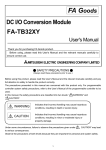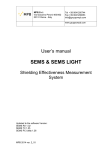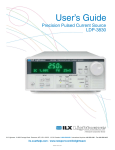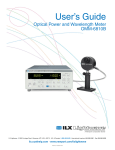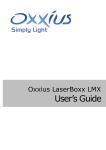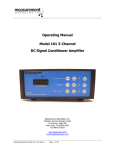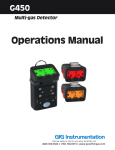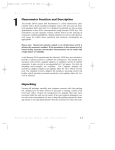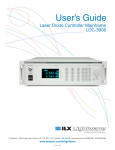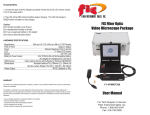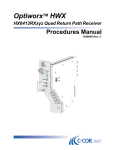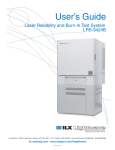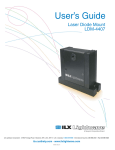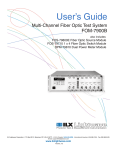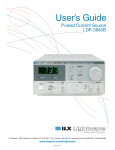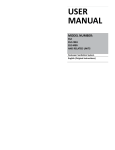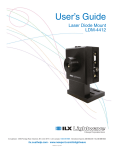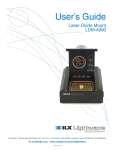Download User`s Guide - Newport Corporation
Transcript
User’s Guide Fiber Optic Power Meter FPM-8220 ILX Lightwave Corporation · 31950 Frontage Road · Bozeman, MT, U.S.A. 59715 · U.S. & Canada: 1-800-459-9459 · International Inquiries: 406-556-2481 · Fax 406-586-9405 ilx.custhelp.com · www.ilxlightwave.com 70044002 March 2013 Table of Contents Safety Information and the Manual .................................................................................. v General Safety Considerations ........................................................................................ v Safety Symbols .............................................................................................................. vi Safety Marking Symbols ................................................................................................. vii Warranty ......................................................................................................................... vii Limitations ....................................................................................................................................... vii Returning an Instrument ................................................................................................ viii Claims for Shipping Damage ......................................................................................................... viii Comments, Suggestions, and Problems ........................................................................ ix Chapter 1: Introduction and Specifications .............................................1 Safety Considerations ..................................................................................................... 1 Product Overview ............................................................................................................ 1 Options and Accessories ................................................................................................. 3 Specifications .................................................................................................................. 4 Chapter 2: General Operation ..................................................................5 Installation ....................................................................................................................... 5 Grounding Requirements ................................................................................................................. 5 AC Line Power Requirements ......................................................................................................... 5 Power up Sequence......................................................................................................................... 5 Firmware Upgradeability .................................................................................................................. 6 GPIB Communication ...................................................................................................................... 6 USB Communication........................................................................................................................ 6 Connecting a Measurement Head ................................................................................................... 6 Tilt Foot Adjustment ......................................................................................................................... 6 Rack Mounting ................................................................................................................................. 6 March 2013 i FPM-8220 Front Panel Operation ..................................................................................................... 7 Power On / Off ................................................................................................................................. 7 Setup ................................................................................................................................................ 7 Mode ................................................................................................................................................ 8 Display ........................................................................................................................................... 10 Error Codes .................................................................................................................................... 11 The FPM-8220 Fiber Optic Measurement Heads .......................................................... 12 Protecting the FMH-8705 Fiber Optic Measurement Head ........................................................... 12 Protecting the FMH-8715 and FMH-87107 Fiber Optic Measurement Heads .............................. 13 Measurements through a Connector ............................................................................................. 13 Measurements through Bare Fiber ................................................................................................ 14 Measuring Higher Power ............................................................................................................... 17 Understanding the Calibration Certificate ...................................................................... 17 Photodetector Responsivity ........................................................................................................... 17 Analog Output (BNC)..................................................................................................... 18 Gain Range Boundaries................................................................................................................. 19 Determining Range ........................................................................................................................ 19 Relating Optical Power to Analog Voltage ..................................................................................... 19 General Operation ......................................................................................................... 21 Warm-up and Environmental Considerations ................................................................................ 21 Summary of Operating Procedures ............................................................................................... 21 Chapter 3: Remote Operation .................................................................23 Remote Operation Features .......................................................................................................... 23 Basic GPIB Concepts .................................................................................................... 24 Data and Interface Messages ........................................................................................................ 24 Talkers, Listeners, and Controllers ................................................................................................ 24 GPIB Cable Connections ............................................................................................................... 24 The GPIB Connector ..................................................................................................... 25 Configuring the GPIB Controller .................................................................................... 27 Changing Operation from Local to Remote ................................................................................... 27 Setting the GPIB Address .............................................................................................................. 27 Basic USB concepts ...................................................................................................... 27 GPIB vs. USB Communication ...................................................................................................... 28 March 2013 ii FPM-8220 Command Syntax .......................................................................................................... 29 Letters ............................................................................................................................................ 29 White Space ................................................................................................................................... 29 Terminators .................................................................................................................................... 30 Command Separators .................................................................................................................... 30 Parameters .................................................................................................................................... 30 Command Tree Structure .............................................................................................. 32 Syntax Summary............................................................................................................................ 32 IEEE 488.2 Common Commands .................................................................................................. 34 Status Reporting ............................................................................................................ 36 Event and Condition Registers ...................................................................................................... 36 Command Timing........................................................................................................................... 38 Sequential / Overlapped Commands ............................................................................................. 38 Query Response Timing ................................................................................................................ 38 Chapter 4: Command Reference .............................................................39 Remote Command Reference Summary....................................................................... 39 Command Reference .................................................................................................... 42 Chapter 5: Troubleshooting ...................................................................67 Troubleshooting Guide .................................................................................................. 68 Optical Measurement Problems .................................................................................................... 71 Error Messages ............................................................................................................. 72 Error Code Tables.......................................................................................................................... 72 March 2013 iii FPM-8220 This page was intentially left blank. March 2013 iv FPM-8220 Safety and Warranty Information Details about cautionary symbols Safety markings used on the instrument Information about the warranty Customer service contact information Safety Information and the Manual Throughout this manual, you will see the words Caution and Warning indicating potentially dangerous or hazardous situations which, if not avoided, could result in death, serious or minor injury, or damage to the product. Specifically: Caution indicates a potentially hazardous situation which can result in minor or moderate injury or damage to the product or equipment. Warning indicates a potentially dangerous situation which can result in serious injury or death. Visible and/or invisible laser radiation. Avoid direct exposure to the beam. General Safety Considerations If any of the following conditions exist, or are even suspected, do not use the instrument until safe operation can be verified by trained service personnel: Visible damage Severe transport stress Prolonged storage under adverse conditions Failure to perform intended measurements or functions If necessary, return the instrument to ILX Lightwave, or authorized local ILX Lightwave distributor, for service or repair to ensure that safety features are maintained. January 2013 v FPM-8220 All instruments returned to ILX Lightwave are required to have a Return Authorization Number assigned by an official representative of ILX Lightwave Corporation. See Returning an Instrument for more information. Safety Symbols This section describes the safety symbols and classifications. Technical specifications including electrical ratings and weight are included within the manual. See the Table of Contents to locate the specifications and other product information. The following classifications are standard across all ILX Lightwave products: Indoor use only Ordinary Protection: This product is NOT protected against the harmful ingress of moisture. Class I Equipment (grounded type) Mains supply voltage fluctuations are not to exceed ±10% of the nominal supply voltage. Pollution Degree II Installation (overvoltage) Category II for transient overvoltages Maximum Relative Humidity: <80% RH, non-condensing Operating temperature range of 0 °C to 40 °C Storage and transportation temperature of –40 °C to 70 °C Maximum altitude: 3000 m (9843 ft.) This equipment is suitable for continuous operation. March 2013 vi FPM-8220 Safety Marking Symbols This section provides a description of the safety marking symbols that appear on the instrument. These symbols provide information about potentially dangerous situations which can result in death, injury, or damage to the instrument and other components. Caution, refer to manual Earth ground Terminal Alternating current Visible invisible radiation Caution, risk of electric shock Protective Conductor Terminal Caution, hot surface Frame or terminal chassis Off: Out position of a bistable push The circle (O) only denotes that mains are off. control. On: in position of bistable push control. The slash (|) only denotes that mains are on and/or laser Warranty ILX LIGHTWAVE CORPORATION warrants this instrument to be free from defects in material and workmanship for a period of one year from date of shipment. During the warranty period, ILX will repair or replace the unit, at our option, without charge. Limitations This warranty does not apply to fuses, lamps, defects caused by abuse, modifications, or to use of the product for which it was not intended. This warranty is in lieu of all other warranties, expressed or implied, including any implied warranty of merchantability or fitness for any particular purpose. ILX Lightwave Corporation shall not be liable for any incidental, special, or consequential damages. If a problem occurs, please contact ILX Lightwave Corporation with the instrument's serial number, and thoroughly describe the nature of the problem. March 2013 vii FPM-8220 Returning an Instrument If an instrument is to be shipped to ILX Lightwave for repair or service, be sure to: Obtain a Return Authorization number (RA) from ILX Customer Service. Attach a tag to the instrument identifying the owner and indicating the required service or repair. Include the instrument serial number from the rear panel of the instrument. Attach the anti-static protective caps that were shipped with the instrument and place the instrument in a protective anti-static bag. Place the instrument in the original packing container with at least 3 inches (7.5 cm) of compressible packaging material. Shipping damage is not covered by this warranty. Secure the packing box with fiber reinforced strapping tape or metal bands. Send the instrument, transportation pre-paid, to ILX Lightwave. Clearly write the return authorization number on the outside of the box and on the shipping paperwork. ILX Lightwave recommends you insure the shipment. If the original shipping container is not available, place your instrument in a container with at least 3 inches (7.5 cm) of compressible packaging material on all sides. Repairs are made and the instrument returned transportation pre-paid. Repairs are warranted for the remainder of the original warranty or for 90 days, whichever is greater. Claims for Shipping Damage When you receive the instrument, inspect it immediately for any damage or shortages on the packing list. If the instrument is damaged, file a claim with the carrier. The factory will supply you with a quotation for estimated costs of repair. You must negotiate and settle with the carrier for the amount of damage. March 2013 viii FPM-8220 Comments, Suggestions, and Problems To ensure that you get the most out of your ILX Lightwave product, we ask that you direct any product operation or service related questions or comments to ILX Lightwave Customer Support. You may contact us in whatever way is most convenient: Phone (800) 459-9459 or (406) 586-1244 Fax (406) 586-9405 On the web at: ilx.custhelp.com Or mail to: ILX Lightwave Corporation P. O. Box 6310 Bozeman, Montana, U.S.A 59771 www.ilxlightwave.com When you contact us, please have the following information: Model Number Serial Number End-user Name Company Phone Fax Description of what is connected to the ILX Lightwave instrument Description of the problem If ILX Lightwave determines that a return to the factory is necessary, you are issued a Return Authorization (RA) number. Please mark this number on the outside of the shipping box. You or your shipping service are responsible for any shipping damage when returning the instrument to ILX Lightwave; ILX recommends you insure the shipment. If the original shipping container is not available, place your instrument in a container with at least 3 inches (7.5 cm) of compressible packaging material on all sides. We look forward to serving you even better in the future! March 2013 ix FPM-8220 This page was intentionally left blank. March 2013 x FPM-8220 Chapter 1: Introduction and Specifications This chapter is an introduction to the FPM-8220 Fiber Optic Power Meter and the FMH-8705, FMH-8715 and FMH-87107 Fiber Optic Measurement Heads. This chapter also includes: Safety considerations and instructions Product Overview Options and accessories Specifications Safety Considerations If any of the following symptoms exist, or are even suspected, remove the FPM-8220 from service. Do not use the FPM-8220 until trained service personnel can verify safe operation. Visible damage Severe transport stress Prolonged storage under adverse conditions Failure to perform intended measurements or functions If necessary, return the FPM-8220 to ILX Lightwave for service and repair to ensure that safety features are maintained. Product Overview The FPM-8220 is a precise and reliable tool for fiber optic power measurement. The FPM-8220 is compatible with the FMH-8705, FMH-8715, and FMH-87107 fiber optic measurement heads. The FMH-8705 accommodates wavelengths from 800 to 1650 nm and accurately measures power over a 86.5 dB dynamic range from +1.5 dBm to -85 dBm. Both the FMH-8715 and the FMH-87107 accommodate wavelengths from 800 to 1650 nm. The FMH-8715 accurately measures power over a 90 dB dynamic range, from +20 dBm to -70 dBm, while the FMH-87107 measures over a range of 90 dB, from +30 dBm to -60 dBm. NIST-traceable calibration assures consistent results. Other features include: Each reading is the average of up to 45 measurements to provide high accuracy even with unstable inputs Store and recall up to ten instrument settings January 2013 1 FPM-8220 Relative power can be displayed by a bar graph on the front panel for visual confirmation of the peaking of optical power in alignment applications 0 to 10 V analog output for fine resolution relative power monitoring A sophisticated USB and GPIB/IEEE 488.2 interface The fiber optic measurement head includes a two meter cable for convenient positioning near the device under test A heavy, robust design for production test workstations Customer upgradeable firmware via USB Figure 1.1 – FPM-8220 Front Panel Figure 1.2 – FPM-8220 Rear Panel March 2013 2 FPM-8220 Options and Accessories Options and accessories available for the FPM-8220 Fiber Optic Power Meter and the FMH-8700 series Fiber Optic Measurement Heads include the following: Description FC Adapter SC Adapter LC Adapter Bare Ferrule Adapter Bare Fiber Adapter Ring Bare Fiber Holder (requires CA-120) Rack Mount Kit, single instrument Rack Mount Kit, dual instrument Rack Mount Kit, FMH Measurement Heads Model / Part Number CA -100 CA -150 CA - 200 CA - 250 CA - 120 BF - 820 RM - 144 RM - 145 RM - 143 The CA-120 bare fiber adapter ring accepts ILX Lightwave BF-820 or Agilent 81000BA bare fiber holders. This compatibility also means you can use the BF-820 bare fiber holder with Agilent or HP power meters. March 2013 3 FPM-8220 Specifications March 2013 4 FPM-8220 Chapter 2: General Operation This chapter describes how to set up and operate the FPM-8220 Fiber Optic Power Meter using the front panel controls. Installation Introduction to the FPM-8220 front panel FMH-8700 series fiber optic measurement head familiarization Analog Output General operating procedures Installation Grounding Requirements The FPM-8220 Fiber Optic Power Meter comes with a three conductor AC power cable. The power cable must be plugged into an approved three-contact electrical outlet or used with a three-contact to two-contact adaptor with the grounding wire connected to an electrical ground (safety ground). ILX Lightwave recommends connecting the instrument only to properly earth grounded receptacles. The power cord connector and power cable meet IEC safety standards. To avoid electrical shock hazard, connect the instrument to a properly earth grounded, three prong receptacle only. Failure to observe this precaution can result in severe injury or death. AC Line Power Requirements The FPM-8220 is factory configured for operation at nominal line voltages of 100, 120, 220, or 240 VAC. Make sure the voltage requirements that are printed on the back panel of the instrument matches the power-line voltage in your area. Contact ILX Lightwave Customer Service if you need to reconfigure the input voltage range. Power up Sequence With the FPM-8220 connected to an AC power source, pressing POWER ( ) supplies AC line power to the instrument and starts the following power-up sequence: All front panel indicators ON, all 7-segment displays indicate "8" All front panel indicators OFF Display shows serial number and firmware version of the meter March 2013 5 FPM-8220 If a measurement head is connected, the display shows the measurement head’s serial number and calibration date. If the measurement head is not connected, the display shows “No Head Connected.” Each display lasts 2-3 seconds. During the front panel indicator test, the FPM-8220 performs a self-test to ensure that internal hardware and software are communicating. If the FPM-8220 cannot successfully complete the test, an error message is displayed. See Appendix A for a complete list of error messages. After the self test, FPM-8220 configuration is set to the same state as when power was last turned off. If you wish, you can use the recall function to quickly get to a different configuration. See Store and Recall for more information. Firmware Upgradeability The firmware on the FPM-8220 can be reinstalled or upgraded via USB 2.0 by contacting the ILX Lightwave team at [email protected]. GPIB Communication The IEEE 488.2 GPIB interface connector is located on the rear panel, directly above the power input (See Figure 1.2 on page 2). The 24-pin connector is tapered to ensure proper orientation of the GPIB cable. Use fingers to tighten the two screws on the cable connector. A total of 15 devices can be connected together on the same GPIB interface bus. The cables have double-sided male/female connectors on each end so that several cables can be stacked. This allows more than one cable to be attached to any one device. However, the maximum length of the GPIB interface bus must not exceed 20 meters (65 feet), or 3 meters (10 feet) per device. USB Communication The USB connector is located on the back rear panel, next to the GPIB connector. This USB connector is the square "B"-style connector. A standard USB A/B cable is required to communicate with the instrument. To communicate to the instrument using USB, install the USB Driver found on the accompanying CD or on the website prior to connecting the unit to the PC. Please refer to Chapter 3 for more detailed instructions on operating the instrument through USB. Connecting a Measurement Head All optical measurement heads interface with the instrument via the 26 pin high density 'D' connector located on the lower left side of the rear panel. Tilt Foot Adjustment The FPM-8220 has front legs that extend to make it easier to view the displays. To use them, rotate the legs downward until they lock into position. Rack Mounting The FPM-8220 conforms to international standards for a 2U height ½ width rack mounting. Available rack mount accessory kits contain detailed mounting instructions. March 2013 6 FPM-8220 Front Panel Operation This section describes the fundamentals of front panel operation for the FPM-8220 Fiber Optic Power Meter. Both of the labeled areas on the front panel, SETUP and MODE, and the display are described below. Figure 2.1 – Front Panel Display Power On / Off The POWER ( ) button applies power to the FPM-8220 and starts the power-up sequence described in Chapter 1. Setup Up Arrow The UP ARROW ( ) is used to increase values for gain adjustment, wavelength, display filter, store and recall bins, GPIB address, and the user calibration factor. In auto gain range operation mode, the arrow key can be used to put the instrument into manual gain range mode. Down Arrow The DOWN ARROW ( ) is used to decrease values for gain adjustment, wavelength, display filter, store and recall bins, GPIB address, and the user calibration factor. In auto gain range operation mode, the arrow key can be used to put the instrument into manual gain range mode. Enter Pressing the ENTER pushbutton stores a new value of the parameter that is currently being adjusted. Recall Pressing RECALL allows the user to recall a stored instrument setup from recall bins numbered 0 to 10. Savable settings include gain range, wavelength, display mode, filter mode, and the user calibration offset value. To select a stored setup, first press the RECALL pushbutton then use the UP ARROW and the DOWN ARROW to select the appropriate recall bin and press ENTER to select the stored bin. Bin 0 Factory default instrument configuration Bin Headinfo Measurement Head information including model number, serial number, and last calibration date. March 2013 7 FPM-8220 Store Pressing STORE allows the user to save an instrument setup, including gain range, wavelength, display mode, filter mode, and user calibration offset value, in bins numbered 1-10. To save a setup, first press the STORE pushbutton, then use the UP ARROW and the DOWN ARROW to select the appropriate store bin and press ENTER. Wavelength By pressing WAVELENGTH (λ) and using the UP ARROW and the DOWN ARROW, the user can adjust the wavelength to that of the input light for accurate power measurements. The wavelength adjustment range is dependent upon the FMH-8700 series Fiber Optic Measurement Head connected to the FPM-8220. Local When the instrument is in remote operation mode, pressing the RECALL pushbutton will put the instrument back to local (front panel) control mode. Remote Upon receipt of a command through either the USB or GPIB interface bus, the instrument automatically enters remote mode; indicated by RMT in the upper right corner of the display. During remote communication, the front panel will be locked. Pressing the RECALL pushbutton will unlock the front panel. GPIB Address Pressing RECALL and the UP ARROW pushbuttons simultaneously will put the instrument in the GPIB address adjust mode. The currently stored GPIB address will appear in the parameter line of the display. Pressing the UP ARROW or the DOWN ARROW changes the address number. Mode dBm/W Pressing dBm/W changes the measurement dimensions from dBm to watts. Pressing the button again changes the dimensions back. REF Pressing and immediately releasing the REF pushbutton puts the instrument into reference measurement mode where the displayed measurement is relative to the set reference value. When in reference mode, the display’s enunciator changes to dB or W, depending on the mode, and a delta symbol is displayed, right justified, in the enunciator field. To set a new reference value, hold REF for five seconds. View Ref To view the set reference value, press the dBm/W and REF pushbuttons simultaneously. The value is displayed for 3 seconds in the parameter line. Auto/Man Pressing AUTO/MAN changes the instrument’s measurement mode to either auto, where the gain range is changed through a firmware algorithm depending on the input, or manual, where the gain range is set by the user. If the instrument is in auto measurement mode, pressing either of the arrow pushbuttons changes the measurement mode to manual. In manual mode, the gain range is displayed on the March 2013 8 FPM-8220 parameter line. Pressing the UP ARROW or the DOWN ARROW changes the gain range. The full scale measurement for each gain range is displayed, right justified, in the parameter field. Each measurement head gain range will depend upon the maximum power and the noise floor for the measurement head. The table below represents a typical list of available gain ranges. Range FMH-8705 FMH-8715 FMH-87107 0 1 3 4 5 6 7 Maximum Power X X 1.4mW +1.5 dBm 3.2pW -85 dBm X 0.1W +20 dBm 0.1nW -70 dBm X ~ 1W +30 dBm 1nW -60 dBm Minimum Power Filter Pressing FILTER offers three display update rates: slow, medium, and fast. Indicator Averaging Update Rate ADC Integration Time SLOW MEDIUM FAST 30 measurements 45 measurements 2 measurements 5 seconds 500 ms 50 ms 145 milliseconds 9 milliseconds 9 milliseconds CAL Pressing CAL initiates the calibration measurement function, which multiplies every measurement by a calibration factor. The range of calibration is 0.500 to 2.500. The default value is 1.000. The LED above the CAL pushbutton will illuminate for any value other than 1.000. Use the UP ARROW and the DOWN ARROW to adjust the calibration factor. Zero Pressing ZERO initiates the meter zero function. Increasing dashes in the numerical part of the display, along with a “Zeroing” enunciator in the parameter line of the display, shows the function’s status. Dependent on auto/manual mode, the 8220 will zero the current gain range or all gain ranges accordingly Display Pressing DISPLAY cycles the bottom dot matrix display from the instrument’s setting information to the brightness of the display to a bar graph. March 2013 9 FPM-8220 Display The bottom dot matrix display can show the instrument’s setting information, the display’s brightness, or a bar graph. Setting Information – Displays from left to right wavelength, filter speed, and gain range/auto. The far right will display gain range if in manual mode or “Auto” if auto gain range. Figure 2.2 – Setting Information in Manual Mode Figure 2.3 – Setting Information in Auto Mode Brightness – When the brightness is displayed, the UP ARROW and the DOWN ARROW adjusts the brightness of the display from 1 to 10. Figure 2.4 – Brightness Display Bar Graph - The bar graph display shows relative input level as a percentage of full scale for each gain range. In fast and medium filter speeds, the bar graph will update at 50ms. In slow filter speed, the bar graph will update every 200ms. March 2013 10 FPM-8220 Figure 2.5 – Bar Graph Display Error Codes The FPM-8220 indicates front panel operation errors on the measurement display with an error code. A complete list of error codes is listed in Chapter 5. March 2013 11 FPM-8220 The FPM-8220 Fiber Optic Measurement Heads The FPM-8220 is compatible with three fiber optic measurement heads: FMH-8705 FMH-8715 FMH-87107 InGaAs, Fiber Optic Measurement Head, Detector Only (+1.5 to -85 dBm) InGaAs, Fiber Optic Measurement Head, Integrating Sphere (+20 to -70 dBm) InGaAs, Fiber Optic Measurement Head, Integrating Sphere (+30 to -60 dBm) The FMH-8705 is a detector only measurement head designed to provide a low optical power measurement range. The FMH-8715 and FMH-87107 use integrating sphere technology to provide high accuracy optical power measurements. More than a simple integrating sphere, the innovative integrating cavity design in the FMH-8715 and FMH-87107 is the primary reason the FMH-8220 Fiber Optic Power Meter is able to deliver excellent repeatability in a production workstation environment. Key features of the measurements heads, and their benefits to you, include: Feature Minimal response to changes in the state of polarization Minimal response to changes in fiber extension in the holder Minimal response to rotating the fiber holder with a non-angled cleave Bare fiber end face cannot contact detector surface Bare and connectorized fiber measurements from the same fiber end face position Production tested bare fiber holder easily guide the fiber to the correct place every time Detector head designed to accept ILX’s BF-820 or Agilent 81000BA bare fiber holders Precision quick-align, threadless adapters for most connector type and the bare fiber holder Benefit Measure loss due to polarization without concern for meter errors Obtain the same results with different users No need to rotate the fiber holder for maximum reading with a non-angled cleave Impossible to damage detector with fiber Compare bare and connectorized fiber measurements with confidence No tedium to slow your testing or introduce errors Use ILX’s BF-820 holder with Agilent power heads or use Agilent’s 81000BA holders in the FPM-8220; this interchangeability means that there is no need to alter procedures, or buy different holders Just push in or pull out; easily selfaligns and snaps into place; no threads Protecting the FMH-8705 Fiber Optic Measurement Head The fiber optic measurement head uses a 3mm detector that has been hermetically sealed in a TO-Can package. To avoid accidental damage the plastic shipping protector should be installed when a fiber optic adapter is not in use. March 2013 12 FPM-8220 Protecting the FMH-8715 and FMH-87107 Fiber Optic Measurement Heads The fiber optic measurement head cavity entrance is small (5mm) so it will not allow debris to enter the cavity; however, over time, dust and pollution in the air can degrade measurement accuracy. After using the head, protect the cavity by covering the aperture with the plastic shipping protector, place the head face down on the table or leave a connector or bare fiber holder in place. Cavity contamination can also happen if you are doing environmental testing where humidity causes condensation. If you suspect the cavity has been contaminated, contact ILX Lightwave Customer Service. In most cases we can clean it and recalibrate it for you. Also, contact ILX Lightwave Customer Service if a replacement protective cap is needed. See Comments, Suggestions, and Problems on page viii for contact information. Measurements through a Connector With the adaptors available from ILX Lightwave, the FMH-8700 series Fiber Optic Measurement Heads can make measurements through most common fiber optic connectors. To install an adapter: 1. Align the mating hole on the connector with the alignment pin on the head. 2. Press it into place, then rotate it slightly until the alignment pin has seated. Make sure the adapter is fully seated around its circumference. Figure 2.6 – Seating the Alignment Pin Small spring-loaded balls (ball plungers) in the side of the adaptor mate with a channel in the FMH-8700 series Fiber Optic Measurement Heads to hold the adaptor in position. Once the adaptor is in place, you can connect fibers repeatedly to the meter. There is no need to remove the adaptor unless you need to use a different connector type. Note: Always clean the tip of the connector ferrule before a measurement, using the proper tools and a good technique. The core of a single-mode telecom-grade fiber is only about 9μm in diameter; the smallest contaminant can cause significant errors. To remove an adaptor, grasp its outer ring and pull it out. March 2013 13 FPM-8220 Measurements through Bare Fiber The aim in developing the FMH-8715 and FMH-87107 was to solve the measurement issues that affect repeatability when the fiber endface is not polished in a connector ferrule. The result is a fiber optic power meter optimized for bare fiber measurements. The measurements are highly repeatable, the meter is easy to use, and the detectors are virtually unaffected by the polarization state of the fiber or by the rotation of the fiber holder. Fiber optic measurement heads, such as the ILX Lightwave FMH-8705, normally have their detector mounted at an angle to prevent reflections back into the input fiber; however, this arrangement is less than ideal for measurements through bare fiber. Among the detractors from measurement repeatability is: The variation in distance from the fiber endface to the detector. If you are not careful, you can scratch the detector face. Slight variations in the angle of the glass cleave at the core exit point. In a standard telecom fiber, the core containing the light is only about 0.5% of the endface surface area and that is the only part that matters for exit angle. Figure 2.7 – Bare Fiber Measurement Diagram The CA-120 Bare Fiber Adapter Ring The CA-120 Bare Fiber Adapter Ring is a round ferrous ring that mounts in the FMH-8700 series Fiber Optic Measurement Heads and mates with magnets in either the ILX Lightwave BF820 Bare Fiber Holder or the Agilent 81000BA Bare Fiber Holder. The adapter ring has no alignment hole so you can just press it into place in the detector head. Check that the adaptor ring is flush to the face of the detector head all around. Rotating the ring helps to ensure that it is seated properly. Figure 2.8 - CA-120 Bare Fiber Adapter Ring March 2013 14 FPM-8220 Measuring with the BF-820 Bare Fiber Holder The ILX Lightwave BF-820 Bare Fiber Holder was designed, tested and optimized for production workstations. Its opening action and internal alignment guides make it easy and fast to correctly place the fiber every time. 1. Carefully strip, clean, and cleave the fiber. Strip the jacket, then strip at least 1.3 cm of buffer (1/2-inch) from the fiber. If the fiber endface touches anything after cleaving, clean it and cleave it again. Note: The BF-820 is designed for 125 m clad fiber. 6810fo_1 Figure 2.9 – Strip and Cleave the Fiber 2. Squeeze the BF-820 bare fiber holder by its feet to open the body and expose the alignment guides. Figure 2.10 – BF-820 Bare Fiber Holder 3. Lay the fiber in the holder with the stripped and cleaved fiber protruding from the nose (detector-side) of the holder. 4. Gently pull the fiber until the buffer is aligned with the marks on the holder. Make sure the buffer does not extend beyond the marks, toward the nose-end of the holder. March 2013 15 FPM-8220 Figure 2.11 – Place Fiber in BF-820 Holder 5. The fiber must extend between1.0 mm and 5.0 mm from the holder to ensure accurate measurements from the FPM-8220. 6. Release the feet and close the holder. The holder is held shut by a spring and several magnets. Grasping the holder by the body, insert the fiber holder into the bare-fiber adaptor ring making sure that the fiber endface does not touch anything. If the fiber endface makes contact with anything, it must be cleaned and recleaved. Note: Make sure to grasp the holder by the body when inserting or removing it from the detector. Grasping the holder by the feet can cause the fiber to come loose. 7. Connect or turn on your light source. Figure 2.12 – Inserting the BF-820 March 2013 16 FPM-8220 Measuring with the Agilent 81000BA Bare Fiber Holder Refer to Agilent documentation for detailed instructions on the use and care of the 81000BA. If you are familiar with the Agilent 81000BA bare fiber holder and have established procedures, the FPM-8220 does not require you to change those procedures. The measurement procedure is the same as the BF-820 described above. Be sure to strip enough fiber to allow 3.0 mm protruding from the front of the Agilent holder after you have the fiber in place. With either bare fiber holder, check that the fiber extension is straight from the front of the holder. If it is not straight, this indicates the holder is bending the fiber. Bending will affect measurement accuracy, and may cause the fiber end to break off. Measuring with Cleaved Angles For some applications, you may want to use a special cleaver capable of cleaving fiber at an angle. This can reduce source instability caused by reflections from the cleaved endface. The FMH-8700 series Fiber Optic Measurement Heads can reliably make this measurement. If your fiber is cleaved at an angle, rotate the fiber holder after inserting it into the head and check whether the rotation effects the measurement. For small cleave angles (<~2×) you will probably not see an effect. For larger cleave angles, rotate the holder for a maximum reading. Be sure there is enough relaxed fiber behind the holder that the rotation does not induce bending stresses. Measuring Higher Power The FMH-8705 will not be damaged by input power up to +10 dBm (10 mW). The FMH-8715 and FMH-87107 will not be damaged by input power up to +40 dBm (10 W) detected for less than 1 minute. However, linearity generally moves outside specification limits above the specified input power limit (see Table 1.2 on page 4). The best way to measure high power is to use a calibrated attenuator. You can then use CAL to set a compensating factor. Understanding the Calibration Certificate Your FPM-8220 and FMH-8700 are supplied with a certificate for NIST traceable calibration from ILX Lightwave's calibration laboratory. The following section explains the information on your calibration certificate. Photodetector Responsivity The FPM-8220 Fiber Optic Meter is a stable, low noise current meter that is compatible with three fiber optic measurement heads: the FMH-8705, the FMH-8715 and the FMH-87107. The FMH-8705 is a detector only, fiber optic measurement head design to measure very low power. The FMH-8715 and FMH-87107 are integrating sphere based fiber optic measurement heads with an integrated photodetector. The integrating sphere randomizes light input, so changes in input polarization and pattern orientation have little net effect on the detector. Factory calibration data is stored in the internal EEPROM of the FMH-8700 series Fiber Optic Measurement Head. Factory calibration is a process of recording the detector current while March 2013 17 FPM-8220 varying the wavelength. The result is a table of detector responses, recorded every 10 nanometers, in A per W. When you input light, the FMH-8700 series of Fiber Optic Measurement Head measures detector current, then uses your wavelength setting to look up the conversion factor on the calibration table. Interpolation algorithms are used for wavelengths between these calibration points. Figure 2.13 is a sample of detector response plotted as a function of wavelength. The chart is based on data from the FMH-8700 series of Fiber Optic Measurement Head calibrations that are performed at ILX Lightwave's NIST-traceable calibration laboratory. 0.0019 Responsivity (A/W) 0.0017 0.0015 0.0013 0.0011 0.0009 0.0007 0.0005 0.0003 0.0001 800 900 1000 1100 1200 1300 1400 1500 1600 Wavelength (nm) Figure 2.13 – Sample Detector Response The detector response is shown as photodetector current (amperes) per unit of optical power (watts). The following are true for all FHM-8700 series Fiber Optic Measurement Heads and are exemplified in the chart in Figure 2.12. The highest detector current (greatest sensitivity) is at the longer wavelengths, normally used for telecom work. Changes in detector response are significant enough that the meter must know the wavelength in order to accurately display optical power. The flatness (or steepness) of the curve at any point is a measure of how much effect an error in wavelength input will have on the measurement result. Detector response is less at shorter wavelengths. Analog Output (BNC) A BNC output connector is provided on the rear panel to give you direct access to the amplified photodetector signal. Keep the FPM-8220 in manual range mode when you use the analog output. This is a very low-noise, stable output that is normalized to 10V to represent percentage of full scale. For example, 7.1V = 71% of range. This information is represented by the bar graph on the front panel but with greater resolution. Since the resolution is mostly determined by the instrument that you connect it to, this output is useful for monitoring small changes. With a typical output impedance of 1000Ω, you can directly connect the meter to most data loggers or digital voltmeters. The analog March 2013 18 FPM-8220 output is most commonly used for relative power measurements or as a controlling input for automatic fiber alignment systems. For such tests, the absolute value, represented by the analog output voltage, is usually not of concern, only the change relative to a starting point. For monitoring relative power measurements, put the meter in auto mode to find the appropriate gain range; then set the meter to manual mode to avoid changing gain ranges during the test. Gain Range Boundaries Understanding how the gain ranges and detector response relate to analog output can be useful in interpreting analog voltage. The gain range is related to the current from the photodetector, not to the direct light power, because the semiconductor photodetector response varies with wavelength. The FPM-8220 meter has eight gain ranges. Each range increases gain by 10 times over the previous range. The analog output varies 0 V to 10 V representing minimum to maximum current output for that range. The maximum current for each range is: Range 0 1 2 3 4 5 6 7 Maximum Current 10mA 1mA 100A 10A 1A 100nA 10nA 1nA Determining Range The FPM-8220 will display the gain range by pressing AUTO/MAN or the UP ARROW or the DOWN ARROW. Relating Optical Power to Analog Voltage The most direct way to relate optical power to analog voltage is to read the power from the front panel or by remote interface while noting the voltage. If you set up a remote interface automated system with a data logger or voltmeter, you can directly correlate power and analog output voltage in your data. You can also get this information from calibrated detector response data. You can get the detector response data in two ways: 1. The remote commands RESP? tells you the calibrated detector response in mA/mW for the specified wavelength. You can get the response for any wavelength by first using the WAVE command: For example: WAVE 1480; RESP? This sequence returns the calibrated detector response for 1480 nm. March 2013 19 FPM-8220 2. The factory calibration certificate includes a table of detector response at every 10 nm. The accuracy of power measurement via the analog output of the FPM-8220 is not a factory specification; however, the user will find it to be stable, reliable, and useful. The following relationship will allow the user to convert analog voltage output into power output. G ∗ Where Vmeas is the voltage measured at the analog voltage output, Gr is the gain of the instrument when operating in range r, and ρ(λ) is the responsivity of the measurement head photodiode. The steps for converting analog voltage to power are as follows: 1. Make sure optical power input is ON. 2. Connect a voltmeter to the analog output. 3. Find the range of the instrument and then look up the gain of that range in the table above. 4. Lookup the photodiode responsivity in the appropriate table on the measurement head’s calibration certificate. 5. Divide the analog voltage by the product of the gain and the responsivity to get the power. As an example, suppose that we are trying to measure the power of a 1550nm laser. We record the analog voltage output, Vmeas, at 3.5V. Query the instrument to determine the gain range. In this example, the gain range is 3 so the gain is 10V/10µA. The gain value is calculated by dividing the full scale voltage range on the instrument in combination with the heads by the maximum current boundary of gain range 3, located on the table above. We then go to table 1 of the calibration certificate for the measurement head and find the responsivity of the head at 1550nm, which is 6.0739E-3 A/W. The power of the laser is: G ∗ March 2013 3.5V 10V/μA ∗ 6.0739 20 3 / 57.62 42.39 FPM-8220 General Operation The discussion below presents guidelines for operation as well as some common operating procedures. Remote operations are discussed in the next chapter. Warm-up and Environmental Considerations To achieve the rated accuracy, allow the FPM-8220 to warm up for at least one hour before use. Operate the meter within the environmental limits specified in Chapter 1. The best accuracy is achieved near the calibration temperatures. Summary of Operating Procedures The following list is a summary of operating procedures, discussed in depth earlier in this chapter. 1. Install the appropriate fiber adaptor in the detector head. Connect your input fiber or patch cord. 2. Recall your previously saved setup by pressing RECALL or by setting the parameters individually as described in the following steps: a. Press WAVELENGTH and adjust the wavelength by pressing the UP ARROW or the DOWN ARROW. b. Press AUTO/MAN to select either auto or manual gain range. In manual gain mode, press the UP ARROW or the DOWN ARROW to adjust the gain. 3. Set the calibration constant by pressing CAL. The factory default for this factor is 1.000. 4. Input power: a. In manual mode, the display "- - - - - OVR" indicates the input power is greater than 97.5% of the range. In auto mode, this indicates input power is greater than 1.4mW for model 8705, 100mW for model 8715, or 1W for model 87107. b. In Manual Range mode, the display "-99.999 dBm” or “0.000 nW” indicates the input power is less than 5.0% of range. In Auto Range mode, this indicates input power is less than 3.2x10-9mW for model 8705, 1.0x10-7mW for model 8715, or 1.0x10-6mW for model 87107. 6. To save a new setup, press STORE followed by the UP ARROW or the DOWN ARROW and select bin number 1 through 10. Then press ENTER. Whether or not you save the instrument’s settings before powering down, they will return, exactly as they were the last time the instrument was used, when the FPM-8220 is rebooted. March 2013 21 FPM-8220 March 2013 22 FPM-8220 Chapter 3: Remote Operation This chapter is an overview of the remote operation of the FPM-8220 Fiber Optic Power Meter. Applying power Connecting to the instrument Front panel operation GPIB (General Purpose Interface Bus) is the common name for ANSI/IEEE Standard 488, an industry standard for interconnecting test instruments in a system. The FPM-8220 also has USB (Universal Serial Bus) so that the instrument can be connected to a computer without a GPIB card. Every operation that you can perform from your FPM-8220 front panel can also be done remotely through the rear panel GPIB or USB interface. In addition, some features are available only through remote operation. For example, the DELAY command automatically sets a delay time before the execution of further commands. Remote control can be useful for building an automated test system that includes other instruments. It is also useful for structuring and collecting data for longer tests, such as environmental and component burn-in tests. Remote Operation Features A concise and straightforward command set Full talk/listen capability Full serial poll capability, with SRQ Full local/remote capability This chapter explains GPIB and USB concepts, system setup, and command syntax. Chapter 4 is a reference guide of FPM-8220 responses to remote commands. This chapter assumes: Your computer has an appropriate GPIB interface or the instrument is connected via USB 2.0. You have a basic knowledge of programming or have informational sources at your disposal. You are familiar with the front panel operating controls on the FPM-8220. (Chapter 2) GPIB interface adaptors and support software for standard desktop PCs are available from several manufacturers. Contact ILX Lightwave Customer Service for more information. January 2013 23 FPM-8220 Basic GPIB Concepts The basic GPIB concepts are not necessary to successfully operate the FPM-8220, but are a useful perspective in understanding GPIB communication. Data and Interface Messages GPIB devices communicate with each other by sending data and interface messages. Data contains device-specific information such as programming instructions, measurement results, and instrument status. Each device has an address number, and ignores all data traffic not addressed to it. Depending on its content, data is often called a "device dependent message" or a "device dependent command". Interface messages manage the bus, with functions such as initializing the bus and addressing or unaddressing devices. In addition, some individual bus lines are designated for this purpose (see below). The end of this chapter includes information on interface messages supported by the FPM-8220. Talkers, Listeners, and Controllers Every GPIB system consists of one or more talkers, listeners and often at least one controller. Talkers supply data and listeners accept data. Controllers designate talkers and listeners. A controller is necessary when the active talkers or listeners must be changed. When the controller is a computer, it often also designates itself as a listener so it can collect data from designated talkers. If there is more than one controller, only one can be the Controller In Charge (CIC). Control can be passed from one computer to another. In a multiple controller system, there can be one System Controller capable of asserting control and becoming the CIC. GPIB Cable Connections Standard GPIB connectors can be connected together (stacked) allowing the system to be configured linearly, or in a star configuration, which is shown in Figure 3.1. March 2013 24 FPM-8220 Figure 3.1 – GPIB Cable Connection The GPIB Connector The standard GPIB connector consists of 16 signal lines in a 24-pin stackable connector, as shown in Figure 3.2. The extra pins are used to make twisted pairs with several of the lines. There are eight data input/output lines, three handshake lines, and five interface management lines. Eight data I/O (DIO) lines carry both data (including device dependent commands) and interface messages. The ATN interface management line determines whether these lines contain data or interface messages. Figure 3.2 - GPIB March 2013 25 FPM-8220 Three handshake lines ensure that all data and messages are reliably transferred: NRFD (not ready for data) indicates whether a device can receive the next byte of data or message. NDAC (not data accepted) indicates whether a receiving device has accepted a byte of data or message. DAV (data valid) indicates that the signal levels on the data lines are stable and available for the receiving device(s) to accept. Five interface management lines control the flow of information: ATN (attention) is set by the controller in charge to define the I/O lines for data or interface messages. IFC (interface clear) is set by the system controller to initialize the bus and assert itself as controller in charge. REN (remote enable) is set by the controller to place addressed devices into remote or local (front panel) control mode. SRQ (service request) can be set by any device in the system to request service from the controller. EOI (end or identify) is used by talkers to identify the end of a message. March 2013 26 FPM-8220 Configuring the GPIB Controller Refer to your computer's GPIB interface documentation for details on how to set it up. These settings are important: Primary GPIB Address 1 through 30 Secondary GPIB Address NONE Timeout 1 second Serial Port Timeout 1 second Terminate Read on EOS No Set EOI with EOS on Writes Yes Type of Compare on EOS 7-bit EOS Byte 00h Please note that overlooking these settings is a common cause of problems. Changing Operation from Local to Remote Sending a command over the GPIB or USB bus automatically puts the instrument in remote mode, which is indicated by the RMT in the upper right corner of the display. When the instrument is in remote mode, all front panel controls are disabled except for the RECALL button. Pressing the RECALL button returns the instrument to local control mode unless the local lockout state has been activated by the host computer. Local lockout disables all front panel controls, including the RECALL button, until this condition is changed by the host computer. Setting the GPIB Address In local mode, press RECALL and the UP ARROW buttons simultaneously to display the GPIB address. While the GPIB address is displayed, you can change it to any of 30 addresses from "01 -" to "- 30 -" by pressing the UP ARROW or the DOWN ARROW. Basic USB concepts Universal Serial Bus (USB) is a specification to establish communication between devices and a host controller, which has effectively replaced a variety of earlier interfaces such as serial and parallel ports. There are three USB standards available, including USB 1.1, USB 2.0, and USB 3.0. Our device is designed to conform to the USB 2.0 standard and USBTMC 488 substandard. USB cables use 4 lines - Power, Ground and a twisted pair differential +/- data lines using NRZI encoding. The USB connectors are designed so that power and ground are applied before the signal lines are connected. When the host powers up it performs the enumeration process by polling each of the Slave devices in turn (using the reserved address 0), assigning each one a unique address and finding out from each device what its speed is and what type of data transfer it wishes to perform. The enumeration process also takes place whenever a device is plugged into an active network. The connectors design along with the process of enumeration and a lot of host software allows devices to be described as "Plug-and-Play". March 2013 27 FPM-8220 When the USB device is enumerated and gets an address from the host, it presents the host with information about itself in the form of a series of descriptors. The device descriptor tells the host the vendor and the product ID. The configuration descriptors offer a power consumption value and a number of interface descriptors. Each of these interface descriptors define a number of endpoints, which are the sources and destinations for data transfers. The endpoint descriptors provide the following detail transfer type: bulk, interrupt, isochronous, direction, packet sizes, bandwidth requirement and repeat interval. In USB communication, a typical transaction consists of a number of packets - a token indicating the type of data that the host is sending or requiring, the data and in some cases an acknowledgement. Each packet is preceded by a sync field and followed by an end of packet marker. These transactions are used to provide four basic data transfer mechanisms, including control, interrupt, bulk, and isochronous types. USBTMC stands for USB Test and Measurement Class. USBTMC is a protocol built on top of USB that allows GPIB-like communication with USB devices. From the user's point of view, the USB device behaves just like a GPIB device. For example, you can use VISA Write to send the *IDN? Query and use VISA Read to get the response. The USBTMC protocol supports service request, triggers and other GPIB specific operations. USBTMC allows instrument manufacturers to upgrade the physical layer from GPIB to USB while maintaining software compatibility with existing software, such as instrument drivers and any application that uses VISA. GPIB vs. USB Communication When using the USB interface, the remote GPIB command set is fully operable. Command syntax does not vary between communication protocols. However, the commands which affect GPIB hardware operation will not be useful. For example, “*SRE” may be sent via USB but and service request (SRQ) via GPIB would not be visible since USB has no hardware to support it. This is because SRQ is a function of the GPIB interface hardware and is not available via USB. All commands received by the USB interface are acknowledged by the instrument transmitting “Ready” when the command operation is complete. Queries are acknowledged by the specific query response message. Multiple commands/queries separated by semicolons and issued as one command string are only acknowledged with a “Ready” response if the entire command string contains no queries. (See the Command Separators section later in this chapter for additional details.) March 2013 28 FPM-8220 Command Syntax The discussions below describe command syntax and structure. You need this information to effectively write GPIB and USB control programs for the FPM-8220. The syntax of FPM-8220 commands follow the rules defined in the ANSI/IEEE-488 standard. ANSI/IEEE-488 uses standard terminology. To clarify understanding, we use simpler terms for this manual. Letters Any command or query must contain all of the letters which are shown in upper case in the command definition. Some of the device dependent commands include additional optional letters shown in lower case in the command reference (Chapter 4). Upper/lower case does not matter to the FPM-8220. It is just used in this manual to identify optional letters. The optional letters must be in the correct sequence. Some examples of what works, and what does not: Table 3.1 – Acceptable and Not Acceptable Spelling Acceptable Not Acceptable DISP DS DISPlay or DISPLAY Displa or DISPL White Space “White space” is normally the space character (space bar). A single white space must separate a command from its parameters or data. For example: Table 3.2 – White Space Acceptable Not Acceptable WAVE 1234 WAVE1234 To enhance readability, one or more white spaces may be used before a comma, semicolon, or terminator. Since the computer normally places the terminator at the end of each command string, this simply means that an extra space character at the end of the command line is acceptable. A query has no space between the mnemonic and the question mark. For example: Table 3.3 – Query Formatting Acceptable Not Acceptable DISPLAY? DISPLAY ? March 2013 29 FPM-8220 Terminators A program message terminator identifies the end of a command string. terminator sequences: <NL> <END> <NL><END> These are the valid Many computers terminate with <CR><NL><END> (Carriage Return – New Line – EOI). A carriage return (<CR>) is read as white space. The FPM-8220 terminates its responses with <NL><END>, unless the TERM command is used to change it. If problems are encountered with remote communication, the terminator string can be the cause. Refer to the computer’s GPIB or USB interface manual for information on configuring its terminator string. Command Separators More than one command may be placed in the same command string if each command is separated by a semicolon. The semicolon can be preceded by one or more spaces. For example: DISPLAY ON;*IDN?;RANGE? DISPLAY ON ; *IDN?; RANGE? Parameters Some commands require a parameter. The parameter must be separated from the command by at least one white space. The syntax symbol <nrf value> refers to the flexible numeric representation defined by the GPIB standard. It means that numbers may be represented in integer or floating point form, or in engineering/scientific notation. The IEEE 488.2 standard uses the names NR1, NR2, and NR3 respectively to denote “integer”, “floating point”, and “scientific notation”. For example the number “twenty” may be represented by any of the following ASCII strings: Table 3.4 – Parameters Integer 20 +20 NR1 Floating Point 20.0 +20.0 NR2 Scientific Notation 2.0E+1 2.0e+1 +2.0E+1 +2.0e+1 NR3 For more information on these definitions, refer to the IEEE 488.2 standard. There are no default values for omitted parameters. If a command is expecting a parameter and nothing is entered, an error is generated. March 2013 30 FPM-8220 For further clarity in programming, the Boolean values of one (1) and zero (0) may be used or their names as indicated in Table 3.5. Table 3.5 – Substitute Parameter Values Substitute Name Value ON 1 OFF 0 March 2013 31 FPM-8220 Command Tree Structure The FPM-8220 Fiber Optic Power Meter device-dependent commands are structured in a tree format as shown in Figure 3.3. Each of the legal paths is shown, followed by its list of path options, followed by the commands themselves. It is recommended that the first-time user begin learning the commands by using the full path notation. Once familiar with the commands, command path shortcuts may be used. Figure 3.3 – Command Path Structure Syntax Summary Commands must contain all of the letters shown in uppercase in the command definition. Optional letters shown in lowercase for some device dependent commands in the command reference (Chapter 4) are useful for clarity, but must be in the correct sequence. A single white space must separate a command from its parameters or data. White space is normally the space character (space bar). Other control characters are also interpreted as white space. Do not use white space before the question mark in a query command. If problems are encountered with communications, the terminator string may be the cause. Refer to the GPIB or USB interface manual for additional information. The instrument accepts <NL>, or <^END>, or <NL><^END> as a command line terminator. Many computers terminate with <CR><NL><^END> (Carriage Return – New Line – EOI). The instrument ignores <CR> (Carriage Return) as white space. The FPM-8220 terminates its responses with <NL><^END>. More than one command may be on the same command line if the commands are separated with semicolons. March 2013 32 FPM-8220 GPIB and USB use flexible representation for numeric parameters: integer, floating point, or engineering/scientific notation. There are no default values for omitted parameters. Some device-dependent commands are compound commands, in which the first mnemonic opens a path to a set of commands relating to that path. The second mnemonic then defines the actual command. Table 3.6 shows some examples of invalid syntax command strings that will produce errors: Table 3.6 – Invalid Syntax Command Strings COMMAND COMMENT SYSTEM ERROR? Missing colon; RANGE:AUTO 1 *IDN? Missing semicolon ADDRESS:GPIB ? Space not allowed before question mark. WAVE1234;*IDN? Space missing between WAVE command and the parameter value 1234. March 2013 33 FPM-8220 IEEE 488.2 Common Commands The IEEE 488.2 Common Commands and Queries are distinguished by the “*” which begins each mnemonic. The diagrams below show the syntax structure for common commands, common command queries, and common commands with numeric data required. Figure 3.4 – Common Command Diagrams Numeric data is required with *PSC (1 = on, 0 = off), *RCL (0 – 10, see front panel Recall function), *SAV (1 – 10, see front panel Store function), and *ESE (0 – 255, see Figure 3.5 – GPIB connector diagram). All the IEEE 488.2 Common Commands supported by the FPM-8220 are listed in Table 3.7. March 2013 34 FPM-8220 Table 3.7 – IEEE 488.2 Common Commands Supported by FPM-8220 *CAL? *CLS *ESE *ESE? *ESR? *IDN *OPC *OPC? *PSC *PSC? *RCL *RST *SAV *SRE *SRE? *STB? *TST? *WAI See Chapter 4 – Command Reference for descriptions of all commands, including common commands, supported by the FPM-8220. March 2013 35 FPM-8220 Status Reporting This section contains information that is relevant for understanding instrument error and status reporting. It also contains information regarding the use of the instrument status for generating interrupts for interrupt driven programs or subroutines. Understanding the Operation Complete definition for the instrument is useful for program synchronization. Event and Condition Registers In addition to the required IEEE 488.2 status reporting structure, the FPM-8220 remote interface provides Event and Condition Registers for power meter operations. The Event Registers are used to report events which occur during the operation of the FPM-8220 Fiber Optic Power Meter. Events differ from conditions in that events signal an occurrence one time, and are not reset until the Event Register is queried or the FPM-8220 is powered off. Conditions reflect the current state of the instrument and therefore may change many times during operation. Querying a Condition Register does not change its contents. Figure 3.5 shows the status reporting scheme of the FPM-8220 Fiber Optic Power Meter. Each of the registers which may be accessed by a command or query has the appropriate command or query written above or below the register representation. For example, the Condition Register may be queried via the “COND?” query. The condition or event registers are logically ANDed with their respective enable registers. These bits are then logically ORed to form a summary message in the status byte for that particular register. March 2013 36 FPM-8220 Figure 3.5 – Status Reporting Scheme Note that Bit 0 of the Standard Event Status Register contains the status of the Operation Complete flag. Enabling this bit via the *ESE command allows the user to update Bit 5 of the Status Byte. Then, if the SRE mask has Bit 5 set, and the user issues an *OPC command, the SRQ signal will be generated upon completion of the currently processed commands. This may be used to initiate service request routines which depend on the completion of all previous commands. This allows the use of the operation complete features of the FPM-8220, without the need for program looping or polling which can tie up the GPIB bus. Operation Complete on the FPM-8220 is defined as: No operations to the power meter hardware are pending. No EEPROM (non-volatile) memory write cycles are in progress. Note: If the GPIB or USB times out while waiting for a response, either set the GPIB time-out longer or use SRQ-generated interrupts. See the GPIB interface manual for time-out configuration or SRQ programming setup. The *OPC, *OPC?, and *WAI commands should not be used inside a calibration routine. March 2013 37 FPM-8220 Command Timing This section describes, for each device-dependent command, whether that command is performed in an overlapped or sequential manner. In other words, it states whether the next command may begin while the first is being executed, or if it must wait until the first command is completed before its execution begins. See the Operation Complete Definition earlier in this chapter for conditions about setting the operation complete flag. Sequential / Overlapped Commands All device-dependent commands are executed in an overlapped manner: subsequent commands may begin before the current command has completed. Some common commands are sequential; the next command must wait until this command has completed. All device-dependent commands are executed in an overlapped manner, except the “DELAY” command which is sequential. The operation complete flag is set after the conditions outlined in the Operation Complete Definition have been satisfied. *WAI is an example of a sequential command which forces the next command to wait until the nooperation flag is true. This is essentially the same as waiting for the OPC flag to become true, because the no-operations-pending flag is used to set the OPC flag (bit 0 of the Standard Event Status Register). Commands which change the status of the instrument limits, or change its mode, step value, or status enable registers, will not have their OPC flag set until all current writing to non-volatile memory has been completed. This ensures the OPC flag is never set prematurely. Query Response Timing Query responses are evaluated at the time the query request is parsed, and not at the time the response message is sent. In most cases, this does not create a problem since the time between parsing a query and sending its response is small. March 2013 38 FPM-8220 Chapter 4: Command Reference This chapter is a guide to all of the device-dependent commands for the FPM-8220 Fiber Optic Power Meter. This chapter is divided into two parts. Overview of the remote commands List of remote commands in alphabetical order within the categories of IEEE 488.2 common commands, device specific commands, and extra commands. Remote Command Reference Summary This section contains all of the commands for the FPM-8220 Fiber Optic Power Meter, listed in alphabetical order. Subsections for each path are presented, listing the commands which are legal for that path. See Figure 3.3 for the command path tree structure. Table 4.1 – Remote Command Summary Reference List (IEEE 488.2 Common Commands and Agilent compatible commands) Name Parameters Function Calibrate internal analog to digital (A/D) converter *CAL? NONE *CLS NONE Resets the Standard Event Register, Status Byte and Error Queue to zero. *ESE 1 Sets the Standard Event Status Enable Register. *ESE? NONE Returns the value of the Standard Event Status Enable Register. *ESR? NONE Returns the value of the Standard Event Status Register. *IDN? NONE Returns the Device Identification string. *OPC 1 Generates the Operation Complete message in the Standard Event Status Register. *OPC? NONE Places an ASCII character 1 into the Output Queue. *PSC 1 Used to avoid any undesirable service requests. *PSC? NONE Queries the Power-On-Status-Clear Flag. *RCL 1 Used to recall a stored setup configuration. *RST NONE Forces a device reset. *SAV 1 Saves the current setup configuration. *SRE 1 Sets the Service Request Enable Register bits to allow generation of userselectable service requests. *SRE? NONE Returns the current contents of the Service Request Enable Register. *STB? NONE Returns the current contents of the Status Byte Register. *TST? NONE Initiates an internal self-test and returns a response when complete. *WAI NONE Prevents executing any further commands until the No-Operation-Pending flag is true. March 2013 39 FPM-8220 Table 4.1 – Remote Command Summary Reference List (Device Specific Commands) Name Parameters 1 CAL:USER CAL:USER? NONE COND? NONE 1 DISPlay NONE DISPlay? Set a user cal gain factor Request the user cal gain factor Request the status condition register Turns the display on/off Returns display state 1 Delays processing of further commands for the defined time (in milliseconds). 1 Set the condition status enable register DELAY ENABle:COND Function ENABle:COND? NONE ENABle:EVEnt 1 Request the condition status enable register Set the event status enable register ENABle:EVEnt? NONE Request the event status enable register ERRors? NONE Request errors since last ERR? request EVEnt? NONE Requests the event status register FILTer 1 Select fast, medium, or slow mode FILTer? NONE MESsage 1 Request the measurement filter setting Store character string into message memory MESsage? NONE Request character string from message memory MODE? NONE Request the measurement mode MODE:DB NONE Select decibels (dB) relative measurement mode MODE:DBM NONE Select logarithmic (dBm) measurement mode MODE:W NONE Select linear (watts) measurement mode POWer? NONE Request the value of measured optical power 1 RADix RADix? RANge Request the radix of numeric responses 1 Set the photodetector current gain range NONE RANge? 1 RANge:AUTO NONE RANge:AUTO? 1 REF REF? NONE RESP? NONE 1 TERM Set numeric responses type NONE Request the photodetector current gain range Set AUTO or MANUAL ranging mode Request status: AUTO or MANUAL range Set a reference level in dBm Request the reference level value Request the calibrated detector responsivity data Define the message terminator TERM? NONE Request the message terminator TIME? NONE Request time since powered ON TIMER? NONE 1 WAVE NONE WAVE? 1 ZERO NONE ZERO? March 2013 40 Requests time since the last TIMER? query Set wavelength for calibrating detector response Request wavelength for detector response Optional. Zero specific range. Request status of zero operation FPM-8220 Table 4.1 – Remote Command Summary Reference List (Extra Commands) Name Parameters 1 DISPlay:BRIGhtness NONE DISPlay:BRIGhtness? 1 DISPlay[:ENABle] DISPlay[:ENABle]? DISPlay:MODE Function Sets the display brightness Returns the display brightness Turns the display on/off NONE Returns display state 1 Sets the display mode DISPlay:MODE? NONE Returns the display mode READ:POWer? NONE Request the value of measured optical power 1 SENSe:CORRection:COLLect:ZERO SENSe:CORRection:COLLect:ZERO? NONE SENSe:POWer:RANGe:AUTO 1 SENSe:POWer:RANGe:AUTO? SENSe:POWer:RANGe:MONitor SENSe:POWer:RANGe:MONitor? 1 Set the photodetector current gain range NONE 1 SENSe:POWer:UNIT SENSe:POWer:UNIT? NONE SENSe:POWer:WAVelength Set AUTO or MANUAL ranging mode Request status: AUTO or MANUAL range 1 SENSe:POWer:REFerence? Request status of zero operation NONE NONE SENSe:POWer:REFerence Apply an internal offset 1 Request the photodetector current gain range Set a reference level in dBm Request the reference level value Selects Logarithmic (dBm) unit or linear units (Watts) to be used in reporting measurements Requests FPM-8220's measurement mode. Set wavelength for calibrating detector response SENSe:POWer:WAVelength? NONE Request wavelength for detector response SLOT:[HEAD]:IDN? NONE Returns the head information SYSTem:COMMunicate:GPIB? NONE Returns the GPIB address NONE Requests the current error in the error queue and then removes this error from the error queue SYSTem:ERRor? March 2013 41 FPM-8220 Command Reference The following pages contain a reference for both common and device-dependent commands of the FPM-8220 Fiber Optic Power Meter. This reference contains useful information for both local and remote operation of the FPM-8220. Common Device Dependent Front Panel *CAL? Action Adjusts the internal analog to digital (A/D) converter to reference points, then reports results. Response Zero = OK Non-zero = calibration error Notes The A/D chip in the FPM-8220 performs automatic calibration. Thus, this query always return 0. Example *CAL? Common Device Dependent Front Panel *CLS Action Clears status event registers: Standard Event Status, Device Event Status, and Error Queue. Notes Useful to clear registers before enabling service requests (SRQ). Example *CLS Common Device Dependent Front Panel *ESE <nrf value> Standard Event Status Enable Action Enables bits in the Standard Event Status Enable Register. Parameters The value must be between 0 and 255. Notes Bit 5 of the Status Byte Register (STB) is set if any enabled conditions are true. Setting Bit 0 allows for generation of service requests from overlapped commands as previous operations complete. This may be useful for ensuring that an operation is complete before starting a measurement. Examples January 2013 “*ESE 40” –action: Sets the Standard Event Status Enable Register to enable Bit 5 of the Status Byte 3 5 Register if a device-dependent error or a command error occurs (40 = 2 + 2 ). 42 FPM-8220 Common Device Dependent Front Panel *ESE? Standard Event Status Enable Query Action Requests the value of the Standard Event Status Enable Register. Parameters None. Notes Bit 5 of the Status Byte Register is set if any enabled conditions are true. Response is the sum of the enabled bits and must be a value between 0 and 255. Examples “*ESE?” –response: 68, meaning the User Request and Query Error bits have been enabled in the 2 6 Standard Event Status Enable Register (68 = 2 + 2 ). Common Device Dependent Front Panel *ESR? Standard Event Status Register Query Action Requests the value of the Standard Event Status Register. Parameters None. Notes Response is the sum of the enabled bits and must be a value between 0 and 255. Allows for the determination of which type of error has occurred. Examples March 2013 “*ESR?” –response: 32, meaning a command error has occurred. 43 FPM-8220 Common Device Dependent Front Panel *IDN? Instrument Identification Action Requests the instrument to identify itself. Parameters None. Notes Returns a comma delimited standard format ASCII identification string, from information stored in the instrument during manufacture. The information includes vendor name, product name, serial number, and firmware version. Examples “*IDN?” –response: ILX Lightwave,8220,82200002,1.0 Common Device Dependent Front Panel *OPC Operation Complete Action Sets the Operation Complete Bit in the Event Status Register when all pending overlapped commands have been completed. Parameters None. Notes See the IEEE 488.2 specification for additional information. Examples *OPC Common Device Dependent Front Panel *OPC? Operation Complete Query Action Places an ASCII character 1 into the instrument’s Output Queue when all pending operations have been finished. Parameters None. Notes See the IEEE 488.2 specification for additional information. Examples *OPC? –response: “1” when all overlapped commands are complete. March 2013 44 FPM-8220 Common Device Dependent Front Panel *PSC <nrf value> Power-on Status Clear Action Sets automatic power-on clearing of the enable registers. Parameters One <nrf value> where 0 = disables power-on clearing and 1 = enables power-on clearing. Notes Registers affected: Device Condition Status Enable Device Event Status Enable Service Request Enable Standard Event Status Enable Factory default condition: Disabled In the disabled state, the values of the enable registers are saved through power OFF/ON. The power-on status clear flag (see *PSC?) is set false, disallowing service request interrupts after poweron. In the enabled state, the enable registers are cleared during power-on. The power-on status clear flag (see *PSC?) is set true, allowing service request interrupts after power-on. Examples *PSC 0 Disable automatic power-on clearing of the enable registers. *PSC 1 Enable automatic power-on clearing of the enable registers. Common Device Dependent Front Panel *PSC? Power-on Status Clear Query Action Requests the status of the power-on status clear flag. Parameters None. Notes Response: 0 – The enable registers are saved through power off/on. 1 – The enable registers are cleared during power on. Registers affected: Device Condition Status Enable Device Event Status Enable Service Request Enable Standard Event Status Enable See Chapter 3 for more information on register structure. Examples *PSC? Request state of power-on status clear flag. Common Device Dependent Front Panel *RCL <nrf value> Recall Action Recalls a stored setup configuration from memory. Parameters One <nrf value> with a value from 0 – 10. Notes Configuration 0 is the factory-set default configuration. If Configuration 0 is recalled via GPIB, the instrument will be in Remote mode. If it is recalled from the font panel, the instrument will be in Local mode. The *SAV function is used to save configurations for convenient recall. The current setup is automatically stored and recalled at the next power-on, unless *PSC is used to enable the power-on status clear flag. Examples March 2013 “*RCL 0” –response: instrument is reconfigured to factory-default settings. 45 FPM-8220 Common Device Dependent Front Panel *RST Reset Action Performs a device reset and sets the OCIS and OQIS states. Parameters None. Notes OCIS = Operation-complete Command Idle State. This is the same as after *OPC – no further operations to complete. OQIS = Operation-complete Query Idle State. This is the same as after *OPC? – no further operations to complete. These states allow the instrument to complete its reset process (no operations pending) before continuing with other operations. Examples *RST Common Device Dependent Front Panel *SAV <nrf value> Save Action Saves the current instrument configuration to non-volatile memory. Parameters One <nrf value> with a value from 1 – 10. Notes Configuration 0 is reserved for the factory-set default configuration. It is normally not necessary to save the current setup for next power-on. The current setup is automatically stored for recall at next power-on, unless the *PSC command is used to clear the power-on status. Examples “*SAV 3” –response: the current instrument configuration is stored in memory location #3. Common Device Dependent Front Panel *SRE <nrf value> Service Request Enable Action Enables bits in the Service Request Enable Register. Parameters An <nrf value> whose sum represents the enabled bits. Notes Refer to Figure 3.5 in Chapter 3 for a complete description of the Status Byte and Service Request Enable Register. Examples “*SRE 136” –action: enables the service request enable register when a device condition summary or an error is available. March 2013 46 FPM-8220 Common Device Dependent Front Panel *SRE? Service Request Enable Query Action Returns the enabled bits in the Service Request Enable Register. Parameters None. Notes The response is the sum of the enabled bits and must be a value between 0 and 255. Refer to Figure 3.5 in Chapter 3 for a complete description of the Status Byte and Service Request Enable Register. Examples “*SRE?” –response: “136” specifies that the device condition summary and error available bits are enabled. Common Device Dependent Front Panel *STB? Status Byte Query Action Returns the value of the Status Byte Register. Parameters None. Notes The response is the sum of the enabled bits and must be a value between 0 and 255. Refer to Figure 3.5 in Chapter 3 for a complete description of the Status Byte and Service Request Enable Register. Examples “*STB?” –response: “200” specifies that the device condition summary, master status summary and error available bits are enabled. Common Device Dependent Front Panel *TST? Self Test Action Performs an internal self-test, then reports results. Parameters None. Notes Response 0 = test completed with no errors. Response non-zero = test not completed or completed with errors. Examples “*TST?” –response: “0” means test completed without errors. Common Device Dependent Front Panel *WAI Wait to Continue Action Prevents the instrument from executing any further commands until OPC (operation complete) status is true. Parameters None. Notes This command can be used to make the instrument wait until an operation is complete before continuing. Care should be taken to set the GPIB time-out appropriately for use with the *WAI command. After this command (or the Delay) command is sent, the instrument may receive up to 20 more commands before the wait period is over. Examples March 2013 “*WAI” –action: wait until OPC status is true. 47 FPM-8220 Common Device Dependent Front Panel CAL:USER <nrf value> Action Sets a gain factor to be applied to all FPM-8220 measurements. Parameters 0.500 to 2.500 Indicators Front panel USER CAL indicator is ON when the gain factor is any other value than 1.000. Examples CAL:USER .5 - Results are half their normal value CAL:USER 1.01 - Results are increased by 1% Common Device Dependent Front Panel CAL:USER? Action Requests the FPM-8220 user-cal gain value. Response A value between 0.500 and 2.500. Examples CAL:USER? - Response 1.000 means there is no user-calibration gain factor. CAL:user? - Response 1.010 means a user-calibration gain factor is increasing all results by 1%. Common Device Dependent Front Panel COND? Action Requests the contents of the device condition status register. Over-range 4 Under-range 8 Measurement data ready 2048 = Unused bits Notes The conditions reported to the status byte are set through the ENABle:COND command. The condition status may be constantly changing, while the event status is only cleared when it is cleared or read. See *CLS and EVEnt? commands. See Chapter 3 for more information about register structure. Examples March 2013 COND? - Response 4 means there is an over-range condition. 48 FPM-8220 Common Device Dependent Front Panel DELAY <nrf value> Action Delays processing of further commands for the defined time (in milliseconds). Parameters 0 to 65535 Notes Decimal values are rounded. Small delay values may have no effect, because of time required for command processing. The actual minimum delay depends on the situation, for example whether a measurement is being done in background. This delay command can be useful for creating delays based on the FPM-8220 clock rather than using the controller's clock. Examples DELAY 2000 - Delay further processing 2 seconds. DELAY 48.2 - Delay further processing 48 milliseconds. Common DISPlay <nrf value> Device Dependent Front Panel Action Turns the front panel display on or off, including all indicators. Parameters 0 = OFF 1 = ON Notes Other non-zero values are interpreted as "1". This command can be useful for working in a dark environment. Examples DISPLAY 0 - Turn off the front panel display. Disp:enab 1 - Enable the front panel display. Common DISPlay? Device Dependent Front Panel Action Requests the front panel display status. Response Returns the display status. 0 means OFF and 1 means ON. Examples DISPLAY? - Response "0" means the display is currently shut off Disp? - Response "1" means the display is in normal state. March 2013 49 FPM-8220 Common Device Dependent Front Panel ENABle:COND <nrf value> Action Enables bits in the device condition status enable register. Paramters 0 to 65535 Numeric Value Over-range 4 Under-range 8 Measurement data ready 2048 = Unused bits Notes Enabled/disabled conditions can be read by ENABle:COND?. Changing condition status may be monitored by COND?. Bit 3 of the status byte register is set if any device enabled conditions are true. See Chapter 3 for more information about register structure. Enable registers normally retain their values through power OFF/ON, unless the power-on status clear flag is set true. See *PSC. Examples ENAB:COND 12 - Enables the condition status register so that over-range and under-range error conditions are summarized in the status byte bit 3 (8 + 4 = 12). Enable:cond #HC - Same as ENAB:COND 12, except using hexadecimal numbering. See RADix. Common Device Dependent Front Panel ENABle:COND? Action Requests the value in the device condition status enable register. Response 0 to 65535 Numeric Value Over-range 4 Under-range 8 Measurement data ready 2048 = Unused bits Notes Enabled/disabled conditions can be set by ENABle:COND?. Changing condition status may be monitored by COND?. See Chapter 3 for more information about register structure. Examples ENAB:COND? - Response 4 means that over range will be reported in status byte bit 3. Enable:COND? - Response #H4 is the same as 4, except using hexadecimal numbering. See RADix. March 2013 50 FPM-8220 Common Device Dependent Front Panel ENABle:EVEnt <nrf value> Action . Enables bits in the device event status enable register. Parameters 0 to 65535 Numeric Value Over-range 4 Under-range 8 Measurement data ready 2048 = Unused bits Notes Enabled/disabled events can be read by ENABle:EVEnt?. Event status may be monitored by EVEnt?. Bit 2 of the status byte register is set if any device enabled events are true, for generation of service requests. See Chapter 3 for more information about register structure. Enable registers normally retain their values through power OFF/ON, unless the power-on status clear flag is set true. See *PSC. Examples ENAB:EVE 4 - Enables over-range event to be summarized in the status byte bit 2. Enable:event #H4 - Same as ENAB:EVE 4, except using hexadecimal numbering. See RADix. Common Device Dependent Front Panel ENABle:EVEnt? Action Requests the value in the device event status enable register. Response a value between 0 and 65535 Numeric Value Over-range 4 Under-range 8 Measurement data ready 2048 = Unused bits Notes Enabled/disabled events can be set by ENABle:EVEnt. Changing event status may be monitored by EVEnt?. See Chapter 3 for more information about register structure. Examples ENAB:EVE? - Response 2048 means that measurement ready will be reported in status byte bit 2. Enable:event? - Response #H800 is the same as 2048, except using hexadecimal numbering. See RADix. March 2013 51 FPM-8220 Common Device Dependent Front Panel ERRors? Action Requests a list of errors which have occurred since the last ERR? request. Parameters None Response ASCII character string: list of error numbers, separated by commas. Notes 0 = no errors reported. See Appendix A for a list of error numbers. Examples ERR?- Response 0 means no errors to report. Errors? - Response 530 means the measurement head is not connected. Common Device Dependent Front Panel EVEnt? Action Requests the value in the device event status register. Response A value between 0 and 65535 Numeric Value Over-range 4 Under-range 8 Measurement data ready 2048 = Unused bits Notes Enabled/disabled events can be set by ENABle:EVEnt. Status bits are set by events, and cleared when read or cleared by command. See *CLS and EVEnt? commands. The measurement ready bit is set whenever the display value is updated. For example, in slow mode a new measurement is ready every 5 seconds. See FILTer below. See Chapter 3 for more information about register structure. Examples EVE? - Response 2052 means that over-range and measurement data ready events occurred since the last EVE? inquiry. Event? - Response #H804 is the same as 2052, except using hexadecimal numbering. See RADix. Common Device Dependent Front Panel FILTer <ASCII string> Action Selects measurement averaging and display update rate. Parameter One of the following strings: Notes Measurement samples are taken every 50 mSec. Examples FILTER SLOW - Updates the display every 5 seconds with the average of 100 measurements. Filter med - Updates the display every 0.5 seconds with the average of 10 measurements. FILT Fast - Turns off measurement averaging. Updates the display every 50 milliseconds. March 2013 SLOW MED FAST 52 FPM-8220 Common Device Dependent Front Panel FILTer? Action Requests the current setting for measurement averaging and display update. Response One of the following ASCII character strings: Notes The filter rate is set by the front panel, or by the FILTer command. Examples FILTER? - Response SLOW means the display is updating every 5 seconds with the average of the previous 100 measurements. Filt? - Response FASTmeans measurement averaging is off and the display is updating every 0.05 seconds. FAST MED SLOW Common Device Dependent Front Panel MESsage <ASCII string> Action Stores an ASCII string into FPM-8220 non-volatile memory. Notes String is 1 to 16 non-zero ASCII characters. Strings longer than 16 characters are terminated to the first 16. Strings shorter than 16 characters are filled with spaces to 16. Message string is retained through power OFF/ON. Useful as a "scratchpad" for storing intermediate test status or configuration information. Examples Message “Test 3" - Stores the string Test 3 in non-volatile memory. Message Test 3 - Same as above. Quotes are optional. Common Device Dependent Front Panel MESsage? Action Requests an ASCII string from FPM-8220 message memory. Response 16-character string, followed by NULL terminator. Notes As necessary, the string is filled with spaces to 16-character length. If no message string was stored, the response is a string of 16 spaces. Examples Message? – Response “Test 3” means the previously stored message was Test 3. Common Device Dependent Front Panel MODE:DB Action Selects Decibels (dB) relative to the reference value to be used in reporting measurements. Notes MODE defines the units of value that will be used for responses to a POW? request. This command has the same effect as selecting the display mode on the front panel. Examples Mode:dB - Measurements will be reported in dB (decibels) relative to the reference value. March 2013 53 FPM-8220 Common Device Dependent Front Panel MODE:DBM Action Selects Logarithmic (dBm) units to be used in reporting measurements. Examples Mode:dBm - Measurements will be reported in dBm. Common Device Dependent Front Panel MODE:W Action Selects Linear (watts) units to be used in reporting measurements. Examples Mode:W - Measurements will be reported in Watts. Common Device Dependent Front Panel MODE? Action Requests FPM-8220's measurement mode. Response One of the following ASCII character strings: Notes This information is available on front panel indicators. See Chapter 2. The response to MODE? is the units of value that will be used for responses to a POW? request. Examples Mode? - Response W means that linear measurement mode (watts) is in effect. dB dBm W Common Device Dependent Front Panel POWer? Action Requests the most recent value of measured optical power. Response Numeric value. Notes Units defined by MODE commands. Value is returned when the next measurement is available in slow mode. It may take up to 5 seconds. In dB or dBm mode, reports the same number as on the display. In W mode, reports in scientific notation. Monitor the Device Event Status Register for over-range or under-range conditions when using this query. Examples March 2013 Mode?;Power? - Response of DBM,-13.584 means the last measured power was-13.584 dBm. MODE:W;POW? - Response 2.795E-006 means the last measured power was 2.795 μW. 54 FPM-8220 Common Device Dependent Front Panel RADix <nrf value> Action Sets the form (radix) of numeric responses. Rad DEC Decimal numbers. (Default type when not specified). Rad HEX Hexadecimal numbers Rad BIN Binary numbers Rad OCT Octal numbers Notes All status, condition, and event requests respond in the selected radix. RADix defines responses, not data entry. To enter data in non-decimal form, use one of the following prefixes: #H Hexadecimal #O Octal #B Binary Examples RAD DEC - Reset to the factory default decimal radix. Radix HEX; *ESR? - Set hexadecimal radix. Response #H80 means power-on was detected. rad oct - Set octal radix. Common Device Dependent Front Panel RADix? Action Requests the current form (radix) of numeric responses. Responses Dec Hex Bin Oct Notes Use the RADix command to change the radix setting. Examples Radix? - Response Hex means numeric responses will be in hexadecimal numbers. Decimal numbers. (Default type). Hexadecimal numbers Binary numbers Octal numbers Common Device Dependent Front Panel RANge <nrf value> Action Sets the FPM-8220 photodetector current gain range. Parameters 0 through 8 Notes The InGaAs photodetector in the FPM-8220 converts optical power into electrical current. The FPM8220 is a stable low noise current meter that uses calibration to report photodetector current as optical power. This current is proportional to optical power, but it also varies with wavelength. For more information about gain ranges, see Gain Ranges on page 19. There are eight ranges in the FPM-8220 meter. Each range increases gain by 10x over the previous range. The maximum photodetector current for each range is as follows Range 0 1 2 3 Maximum Current 10 mA 1 mA 100 µA 10 µA Range 4 5 6 7 Maximum Current 1 µA 100 nA 10 nA 1 nA Setting the gain range puts the FPM-8220 into MANUAL range mode. Examples March 2013 Range 5 - Set the photodetector current gain to range 5: 100 nA full scale RAN 6 - Set the photodetector current gain to range 6: 10 nA full scale 55 FPM-8220 Common Device Dependent Front Panel RANge? Action Requests the FPM-8220 photodetector current gain range. Response Integer number: 0 through 7 Notes See the discussion of RANge above for information about gain ranges. Response is valid whether the FPM-8220 is in MANUAL or AUTO range mode. Range information is not displayed on the FPM-8220 front panel. Example Range - Response 5 means photodetector current gain is to range 5: 100 nA full scale Common Device Dependent Front Panel RANge:AUTO <nrf value> Action Sets the FPM-8220 into AUTO or MANUAL ranging mode. Values 0 = MANUAL ranging 1 = AUTO ranging Notes Same function as pressing AUTO/MAN on the front panel. Examples Range:AUTO 1 - Set the FPM-8220 into AUTO ranging mode. RAN:AUTO 0 - Set the FPM-8220 into MANUAL ranging mode. Common Device Dependent Front Panel RANge:AUTO? Action Requests the status of AUTO or MANUAL range mode. Response 0 = MANUAL ranging, 1 = AUTO ranging Notes This information is available on a front panel indicator. Examples Range:AUTO? - Response 1 means the FPM-8220 is in AUTO ranging mode. Common Device Dependent Front Panel REF <nrf value> Action Sets a reference level in dBm. Parameters +30 to -120 Notes Measurements in dB are reported relative to this reference level. See MODE:DB. "+" is accepted but not necessary for positive values. Front panel operation allows you to set the reference to the most recent measurement.. However the GPIB command allows you to set any arbitrary reference level. Examples REF 0 - Set reference level to 0 dBm (1 mW). Ref -18.24 - Set reference level to -18.24 dBm (15 μW). Mode:dBm;Power? - Get most recent power measurement in dBm. REF <power> - Using the result <power>, set the reference to the most recent power measurement. March 2013 56 FPM-8220 Common Device Dependent Front Panel REF? Action Requests the reference level value. Response GPIB-standard nrf value, in the units currently defined. See MODE. Notes Same function as pressing dBm/W and REF together on the front panel. Examples REF? - Response 0 means the reference level is 0 dBm. Ref? - Response -20 means the reference level is -20 dBm (10 μW). Ref? - Response 2.795E-006 means the reference level is 2.795 μW. Common Device Dependent Front Panel RESP? Action Requests the calibrated detector responsivity for the currently selected wavelength. Response GPIB standard <nrf value>, in units: mA / mW Notes The information should correspond with that on your latest ILX Lightwave calibration certificate for this meter. If not, contact ILX Lightwave Customer Service to resolve the discrepancy. This information can be useful for understanding the characteristics of your FPM-8220 meter. Notice for example that detector current is much less at shorter wavelengths. For more information, see the discussion of the calibration certificate at the end of Chapter Two. Examples RESP? - Response 1.193E-2 means the detector produces 0.01193 mA/mW at the currently set wavelength. Common Device Dependent Front Panel TERM <nrf value> Action Defines the message terminator. Paramters 0= 1= 2= 3= 4= 5= 6= Notes All settings other than TERM 4 are technically out of compliance with IEEE-488.2 specifications. However they are provided for flexible compatibility with various GPIB drivers. <CR><NL><^END> <CR><NL> <CR><^END> <CR> <NL><^END> FPM-8220 default and IEEE-488.2 Standard <NL> <^END> TERM 3 will often cause "bus hang" problems, because IEEE-488.2 compliant instruments ignore the <CR> as white space, causing them to wait indefinitely for message termination. Meanings of the acronyms are historical: CR = Carriage Return (e.g.: a mechanical typewriter) NL = New Line (e.g.: line-feed on a "line printer") ^END = EOI code (End Or Identify) Examples March 2013 Term 4 - Define the message terminator as the IEEE-488.2 standard: <NL><^END> 57 FPM-8220 Common Device Dependent Front Panel TERM? Action Requests the currently defined message terminator. Response 0 through 6, interpreted as follows: 0= <CR><NL><^END> 1= <CR><NL> 2= <CR><^END> 3= <CR> 4= <NL><^END> IEEE-488.2 Standard and FPM-8220 default 5= <NL> 6= <^END> Notes All settings other than TERM 4 are out of compliance with IEEE-488.2 specifications. They are provided for flexible compatibility with various GPIB drivers. See TERM (above) for more information. Examples Term? - Response 4 means the message terminator is the FPM-8220 default: <NL><^END> Common Device Dependent Front Panel TIME? Action Requests the time since the last time the FPM-8220 was powered ON. Response ASCII character data in the form hours:minutes:seconds Notes Maximum time (clock "turns over") is1193 hours (~50 days). The TIME clock is independent of the TIMER clock. See TIMER? below. Examples Time? - Response 0:32:01.76 means 32 minutes and 1.76 seconds have elapsed since power-ON. Common Device Dependent Front Panel TIMER? Actions Requests the time since the last TIMER? query. Resets the TIMER clock to zero. Response ASCII character data in the form hours:minutes:seconds Notes Maximum time (clock "turns over") is 1193 hours (~50 days). The TIMER clock is independent of the TIME clock. See TIME? above. The TIMER clock is set to zero at power-ON, so the first response will be the same as a TIME? query. Examples Timer? - Response 0:00:12.07 means 12.07 seconds have elapsed since the last TIMER? query. March 2013 58 FPM-8220 Common Device Dependent Front Panel WAVE <nrf value> Action Sets the wavelength (in nanometers) to be used in calibrating detector response. Parameters 800 to 1650 Notes The FPM-8220's InGaAs detector produces current in proportion to light input. The amount of current varies also with wavelength. For this reason, it is important to give the FPM-8220 correct wavelength information.Calibration points are basically every 10 nm. When you give the FPM-8220 a wavelength between two calibration points, the resulting calibration factor is a linear interpolation between the two points. Examples WAVE 1552 - Set wavelength response to 1552 nm. The calibration factor will be interpolated to include 20% of the change in calibration points from 1550 nm to 1560 nm. Common Device Dependent Front Panel WAVE? Action Requests the wavelength to be used in calibrating detector response. Response A GPIB-standard nrf value of the current wavelength setting. See WAVE above. Notes This information is available on the FPM-8220 front panel. Examples WAVE? - Response 1552 means FPM-8220 wavelength response is set to 1552 nm. The calibration factor will be interpolated to include 20% of the change in calibration points from 1550 nm to 1560 nm. Common Device Dependent Front Panel ZERO [<nrf value>] Action Applies an offset to internal FPM-8220 amplifiers to eliminate fixed errors from such effects as detector dark current and ambient light. Notes This function is the same as the front panel ZERO button. Optional values 0 – 7; if no parameter passed, all ranges are zeroed. Before starting measurements it is good practice to first zero the meter. The concept is similar to shorting the leads of a voltmeter and making sure the meter reads zero. To eliminate all offsets, no light must be on the detector. A connector adaptor can be used for this purpose, provided a patch cord is connected and the other end of the fiber is not exposed to ambient light. You can usually use ZERO with your test setup connected to eliminate small external effects such as ambient room light from your measurement. However, the FPM-8220 limits the amount of offset because large external influences are too unstable to include in measurements. Error “Zeroing error” results when there is too much ambient light for the zero operation. The FPM-8220 keeps the last zero setting, even when you turn power OFF. So if you zero the meter to your test setup, be sure to zero the meter again when you are finished. It may be more convenient to do this with the front panel ZERO button. After ZERO, you should confirm completion with ZERO?. Then check the error queue (see ERRors?) before proceeding. You can interrupt the zero process from the front panel even if it was initiated by GPIB by pressing the front panel ZERO button before it completes. If the zero process is interrupted or was not successful, gain offsets for the remaining unzeroed gain ranges remain unchanged. Examples March 2013 ZERO - Start the zero process for all ranges. ZERO 2 – Zeros range 2 59 FPM-8220 Common Device Dependent Front Panel ZERO? Action Requests status of the FPM-8220 zero operation. Response 0 = zero operation is not in progress. 1 = zero operation is in progress. Examples ZERO? - Response 1 means the zero operation is in progress. Zero? - Response 0 means the zero process is not in progress. If you just issued a ZERO command, this confirms the process is complete. DISPlay:BRIGhtness <nrf value> Common Device Dependent Front Panel Action Set the display brightness. Parameters 1 to 10 Examples DISPlay:BRIGhtness 10 – Set the display to the highest brightness Common DISPlay:BRIGhtness? Device Dependent Front Panel Action Requests the display brightness. Response 1 to 10. Examples DISP:BRIG? - Response "5" means the display brightness is 5, which is medium brightness Common DISPlay[:ENABle] <nrf value> Device Dependent Front Panel Action Turns the front panel display on or off, including all indicators. Parameters 0 = OFF 1 = ON Notes Other non-zero values are interpreted as "1". This command can be useful for working in a dark environment. Examples DISPLAY 0 - Turn off the front panel display. Disp:enab 1 - Enable the front panel display. March 2013 60 FPM-8220 Common DISPlay[:ENABle]? Device Dependent Front Panel Action Requests the front panel display status. Response Returns the display status. 0 means OFF and 1 means ON. Examples DISPLAY? - Response "0" means the display is currently shut off Disp? - Response "1" means the display is in normal state. Common DISPlay:MODE <nrf value> Device Dependent Front Panel Action Set the display mode. Parameters One of the following string: NORMAL BRIGHTNESS BARGRAPH Examples DISPlay:MODE BARGRAPH – Set to the bar graph display mode Common DISPlay:MODE? Device Dependent Front Panel Action Requests the display mode. Response One of the following string: NORMAL BRIGHTNESS BARGRAPH Examples DISP:MODE? - Response "NORMAL” means the display is in normal display, which will show the wavelength, filter mode, and auto/manual range mode. Common Device Dependent Front Panel READ:POWer? Action Requests the most recent value of measured optical power. Response Numeric value. Notes Units defined by MODE commands. Value is returned when the next measurement is available in slow mode. It may take up to 5 seconds. In dB or dBm mode, reports the same number as on the display. In W mode, reports in scientific notation. Monitor the Device Event Status Register for over-range or under-range conditions when using this query. Examples March 2013 Mode?;READ:POWer? - Response of DBM,-13.584 means the last measured power was-13.584 dBm. 61 FPM-8220 SENSe:CORRection:COLLect:ZERO [<nrf value>] Common Device Dependent Front Panel Action Applies an offset to internal FPM-8220 amplifiers to eliminate fixed errors from such effects as detector dark current and ambient light. Notes This function is the same as the front panel ZERO button. Optional values 0 – 7; if no parameter passed, all ranges are zeroed. Before starting measurements it is good practice to first zero the meter. The concept is similar to shorting the leads of a voltmeter and making sure the meter reads zero. To eliminate all offsets, no light must be on the detector. A connector adaptor can be used for this purpose, provided a patch cord is connected and the other end of the fiber is not exposed to ambient light. You can usually use ZERO with your test setup connected to eliminate small external effects such as ambient room light from your measurement. However, the FPM-8220 limits the amount of offset because large external influences are too unstable to include in measurements. Error “Zeroing error” results when there is too much ambient light for the zero operation. The FPM-8220 keeps the last zero setting, even when you turn power OFF. So if you zero the meter to your test setup, be sure to zero the meter again when you are finished. It may be more convenient to do this with the front panel ZERO button. After ZERO, you should confirm completion with ZERO?. Then check the error queue (see ERRors?) before proceeding. You can interrupt the zero process from the front panel even if it was initiated by GPIB by pressing the front panel ZERO button before it completes. If the zero process is interrupted or was not successful, gain offsets for the remaining unzeroed gain ranges remain unchanged. Examples SENSe:CORRection:COLLect:ZERO - Start the zero process for all ranges. SENSe:CORRection:COLLect:ZERO 2 – Zeros range 2 SENSe:CORRection:COLLect:ZERO? Common Device Dependent Front Panel Action Requests status of the FPM-8220 zero operation. Response 0 = zero operation is not in progress. 1 = zero operation is in progress. Notes Since the OPC flag is held false during the zero process, zero status can also be determined by checking OPC status. See *OPC?. Examples SENSe:CORRection:COLLect:ZERO? - Response 1 means the zero operation is in progress. SENSe:CORRection:COLLect:ZERO? - Response 0 means the zero process is not in progress. If you just issued a SENSe:CORRection:COLLect:ZERO command, this confirms the process is complete. SENSe:POWer:RANGe:AUTO <nrf value> Common Device Dependent Front Panel Action Sets the FPM-8220 into AUTO or MANUAL ranging mode. Values 0 = MANUAL ranging 1 = AUTO ranging Notes Same function as pressing AUTO/MAN on the front panel. Examples SENSe:POWer:RANGe:AUTO 1 - Set the FPM-8220 into AUTO ranging mode. SENSe:POWer:RANGe:AUTO 0 - Set the FPM-8220 into MANUAL ranging mode. March 2013 62 FPM-8220 Common Device Dependent Front Panel SENSe:POWer:RANGe:AUTO? Action Requests the status of AUTO or MANUAL range mode. Response 0 = MANUAL ranging, 1 = AUTO ranging Notes This information is available on a front panel indicator. Examples SENSe:POWer:RANGe:AUTO? - Response 1 means the FPM-8220 is in AUTO ranging mode. Common Device Dependent Front Panel SENSe:POWer:RANGe:MONitor <nrf value> Action Sets the FPM-8220 photodetector current gain range. Parameters 0 through 8 Notes The InGaAs photodetector in the FPM-8220 converts optical power into electrical current. The FPM8220 is a stable low noise current meter that uses calibration to report photodetector current as optical power. This current is proportional to optical power, but it also varies with wavelength. For more information about gain ranges, see Gain Ranges on page 18. There are eight ranges in the FPM-8220 meter. Each range increases gain by 10x over the previous range. The maximum photodetector current for each range is as follows Range 0 1 2 3 Maximum Current 10 mA 1 mA 100 A 10 A Range 4 5 6 7 Maximum Current 1 A 100 nA 10 nA 1 nA Setting the gain range puts the FPM-8220 into MANUAL range mode. Examples SENSe:POWer:RANGe:MONitor 5 - Set the photodetector current gain to range 5: 100 nA full scale Common Device Dependent Front Panel SENSe:POWer:RANGe:MONitor? Action Requests the FPM-8220 photodetector current gain range. Response Integer number: 0 through 7 Notes See the discussion of SENSe:POWer:RANGe:MONitor above for information about gain ranges. Response is valid whether the FPM-8220 is in MANUAL or AUTO range mode. Range information is not displayed on the FPM-8220 front panel. Examples SENSe:POWer:RANGe:MONitor?- Response 5 means photodetector current gain is to range 5: 100 nA full scale March 2013 63 FPM-8220 SENSe:POWer:REFerence <nrf value> Common Device Dependent Front Panel Action Sets a reference level in dBm. Parameters +30 to -120 Notes Measurements in dB are reported relative to this reference level. See MODE:DB. "+" is accepted but not necessary for positive values. Front panel operation allows you to set the reference to the most recent measurement. However the GPIB command allows you to set any arbitrary reference level. Examples SENSe:POWer:REFerence 0 - Set reference level to 0 dBm (1 mW). SENSe:POWer:REFerence -18.24 - Set reference level to -18.24 dBm (15 μW). Mode:dBm;Power? - Get most recent power measurement in dBm. SENSe:POWer:REFerence <power> - Using the result <power>, set the reference to the most recent power measurement. Common Device Dependent Front Panel SENSe:POWer:REFerence? Action Requests the reference level value. Response GPIB-standard nrf value, in the units currently defined. See MODE. Notes Same function as pressing dBm/W and REF together on the front panel. Examples SENSe:POWer:REFerence? - Response 0 means the reference level is 0 dBm. SENSe:POWer:REFerence? - Response -20 means the reference level is -20 dBm (10 μW). SENSe:POWer:REFerence? - Response 2.79565E-006 means the reference level is 2.79565 μW. Note the change in units. Common Device Dependent Front Panel SENSe:POWer:UNIT <nrf value> Action Selects Logarithmic (dBm) unit or linear units (Watts) to be used in reporting measurements Parameters 0 = logarithmic unit 1 = linear unit Notes dBm is the log of the ratio of output power relative to one milliwatt. Examples SENSe:POWer:UNIT 0 - Measurements will be reported in dBm. Common Device Dependent Front Panel SENSe:POWer:UNIT? Action Requests FPM-8220's measurement mode. Response 0 = logarithmic unit 1 = linear unit Notes This information is available on front panel indicators. See Chapter 2. Examples SENSe:POWer:UNIT? - Response 0 means that logarithmic measurement mode (dBm) is in effect. March 2013 64 FPM-8220 SENSe:POWer:WAVelength <nrf value> Common Device Dependent Front Panel Action Sets the wavelength (in nanometers) to be used in calibrating detector response. Parameters 800 to 1650 Notes The FPM-8220's InGaAs detector produces current in proportion to light input. The amount of current varies also with wavelength. For this reason, it is important to give the FPM-8220 correct wavelength information. Calibration points are basically every 10 nm. When you give the FPM-8220 a wavelength between two calibration points, the resulting calibration factor is a linear interpolation between the two points. Examples SENSe:POWer:WAVelength 1552 - Set wavelength response to 1552 nm. The calibration factor will be interpolated to include 20% of the change in calibration points from 1550 nm to 1560 nm. Common Device Dependent Front Panel SENSe:POWer:WAVelength? Action Requests the wavelength to be used in calibrating detector response. Response A GPIB-standard nrf value of the current wavelength setting. See SENSe:POWer:WAVelength above. Notes This information is available on the FPM-8220 front panel. Examples SENSe:POWer:WAVelength? - Response 1552 means FPM-8220 wavelength response is set to 1552 nm. The calibration factor will be interpolated to include 20% of the change in calibration points from 1550 nm to 1560 nm. Common Device Dependent Front Panel SYSTem:COMMunicate:GPIB? Action Returns the GPIB address. Parameters 1 to 30 Examples SYSTem:COMMunicate:GPIB? – Response 12 means that the GPIB address is set to 12. Common Device Dependent Front Panel SYSTem:ERRor? Action Requests the current error in the error queue and then removes this error from the error queue. Parameters None Response ASCII character string: Error number and error description separated by commas. Notes See Appendix A for a list of error numbers. Examples SYSTem:ERRor?- Response 0,”No error” means no errors to report. SYSTem:ERRor? - Response 530, “Measurement head error” means the head is not connected. March 2013 65 FPM-8220 March 2013 66 FPM-8220 Chapter 5: Troubleshooting This chapter is to help you resolve problems quickly. If you need help, contact ILX Lightwave Customer Service. See page viii for contact information. ILX Lightwave Corporation provides in-house and on-site calibration services for ILX instruments. Most ILX instruments, including the FPM-8220 require yearly calibration to ensure performance to published specifications. ILX factory calibrations employ NIST traceable measurement instrumentation, and our calibration engineers and technicians use automated test equipment to accurately and efficiently capture and record calibration data. An original certificate of calibration authenticity is provided with all instrument calibrations, and a detailed report showing any pre-calibration out-of-tolerance conditions is available upon request. Calibration turn-times are normally five business days or less. On-site calibrations can be performed around your production schedule, night or day, seven days a week. Please contact ILX Customer Support (see Comments, Suggestions, and Problems on page viii for contact information) for additional calibration information. For further assistance with technical solutions and troubleshooting, visit us online at www.newport.com/ilxlightwave. January 2013 67 FPM-8220 Troubleshooting Guide This section lists some common problems and corrective actions. The corrective actions may not solve the problem; in which case, you should contact ILX Lightwave. For a comprehensive list of frequently asked questions, see the ILX Lightwave website or contact ILX Lightwave Customer Service (see Comments, Suggestions, and Problems on page viii for contact information). Symptom Corrective Action The instrument does not power up Check the power cord to make sure that it is properly connected and check the wall outlet by connecting to operational instrument. The display reads “Zeroing Error” Error message E-531 normally indicates that there is too much environmental light to properly zero the meter. The detector head must be connected to a fiber and the source’s output must be turned off. Display shows ”------OVER” There is too much optical power input for the range. Press the DOWN ARROW to change the gain range or select AUTO/MAN, the auto indicator appears in the display, to automatically select an appropriate gain range. You can then select AUTO/MAN again if you want to lock it into one range manually. If you see an “------OVER” indication in auto-range mode or in the highest range (lowest gain), the optical power input is beyond the FPM-8220’s upper limit. If you see an “------OVER” indication in manual-range mode, then the optical power input is greater than 97.5% of full scale for the current gain range. Display shows ”------LOW” Not enough optical power input for the range. Press the DOWN ARROW to change the gain range or select AUTO/MAN, the auto indicator is on in the display, to automatically select an appropriate gain range. You can then select AUTO/MAN again if you want to lock it into one range manually. If you see a ”------LOW” indication in auto-range mode, or in the lowest range (highest gain), the optical power input is below the FPM-8220's lower limit. If you see a ”------LOW” indication in manual-range mode, then the optical power input is less than 5.0% of full scale for the current gain range. The instrument reads “Internal Communication Error” March 2013 E-532 is the internal communication error indicating, the FPM-8220 platform, is not functioning correctly. The instrument must be returned to ILX Lightwave if this error occurs. 68 FPM-8220 No response from a remote command and the RMT indicator is off Check that a GPIB or USB A/B cable, from the system controller, is connected to the FPM-8220. If you are using GPIB, the cable should be less than 3 meters (10 feet) long. Press RECALL and the UP ARROW at the same time to display the GPIB address for three seconds. If it is not correct, change it by pressing the UP ARROW or the DOWN ARROW until you see the correct address. Check that your controlling software is sending commands to the correct GPIB address or with the correct terminating character. Check that no two devices are set to the same GPIB address. Make sure that there are less than 15 devices on the bus. Check that total GPIB cable length is less than 20 meters (65 feet). Check the configuration of your GPIB controller card or COM port. Specifically note the information regarding the terminating character. Remove all other instruments from the GPIB bus to isolate the FPM-8220. If this corrects the problem, re-connect one instrument at a time until the problem returns. Then check the other instrument for address conflicts and proper GPIB function. Read the error queue remotely (ERR?). The command syntax or command structure may be in error. Read the status byte (*STB?) and condition register (COND?) for possible device problems. Slow or unexpected response to remote commands Check that no two devices are set to the same GPIB address. Make sure that there are less than 15 devices on the bus. Check the configuration of your GPIB controller card or COM port. Specifically note the information regarding the terminating character. Check that total GPIB cable length is less than 20 meters. Remove all other instruments from the bus to isolate the FPM-8220. If this corrects the problem, re-connect one instrument at a time until the problem returns. Then check the other instrument for address conflicts and proper GPIB function. March 2013 69 FPM-8220 Is the FPM-8220 ANSI/IEEE 488.2 compatible? The FPM-8220 is IEEE 488.2 compliant. Problems using the Device Clear The DCAS interrupt is not connected to the necessary microprocessor for clearing bus-hung conditions via Device Clear. The firmware does not terminate or complete all commands upon a Device Clear because of firmware/hardware timing issues and GPIB/USB architecture. Instrument is reading “NO HEAD CONNECTED” March 2013 The instrument reads “NO HEAD CONNECTED” if it cannot locate a compatible head. Confirm that the connected head is an FMH-8700 and that the connector is secure. If the instrument still does not recognize the head, check that there are no bent pins in the connector. If there are, straighten the pin with needle nose pliers to ensure that it does not re-bend. 70 FPM-8220 Optical Measurement Problems Symptom Corrective Action Inconsistent readings Make sure the connector adaptor is flush with the head. Verify the quality of cleave and the placement in the bare fiber holder. Rotate the connector adaptor until alignment pin snaps into place. Verify the fiber ferrule is clean. Poor PDR measurement Dirty head Make sure you are using good, low PDL paddles. Contact Customer Service; head needs to be sent in for cleaning. ZERO function does not work Error message 531, “zeroing error” normally indicates that there is too much environmental light to properly zero the meter. The detector head must be connected to a fiber and the source’s output must be turned off. The instrument performs continuous calculations based on wavelength responsivity and the minimum and maximum power specifications for the attached head. If the calculated power sensitivity for a gain range is outside the head’s operating parameters the gain range selection will not be permitted. The instrument reports an error when setting a gain range between 0 and 7 by remote command, the gain range changes when changing wavelength, or a particular gain range cannot be selected from the front panel. Remotely, when a gain range specified is outside operational parameters, the instrument adds the error message “Data out of range” to the error queue. The closest valid gain range to the specified gain range will be selected. March 2013 71 FPM-8220 Error Messages Error messages may appear on the FPM-8220 display when error conditions occur in the instrument. In remote operation, use ERR? to read the current error list or SYST:ERR? to read the latest error. The ERR? command returns a string containing up to 10 of the error messages that are currently in the error message queue. Error Code Tables The error codes are classified and placed in tables corresponding to their classification. The classifications are Command Errors, Execution Errors, Device Errors, Query Errors and Instrument Specific Errors. Table 5.1 - Command Errors Error Code Explanation -104 -108 -113 -115 -121 -123 -151 -160 -161 Data type error Parameter not allowed Undefined header Unexpected number of parameters Invalid character in number Exponent too large Invalid string data Block data error Invalid block data Table 5.2 - Execution Errors Error Code Explanation -220 -222 Parameter error Data out of range Table 5.3 - Device Errors Error Code Explanation -311 Memory error Table 5.4 - Query Errors Error Code Explanation -410 -420 Query interrupted Query unterminated Table 5.5 - Instrument Specific Errors Error Code Explanation 530 531 532 Measurement head error Zeroing error Internal communication error (the instrument needs to be returned to ILX) March 2013 72 FPM-8220





















































































